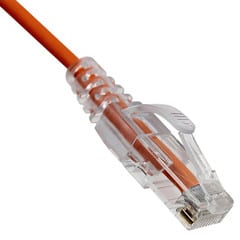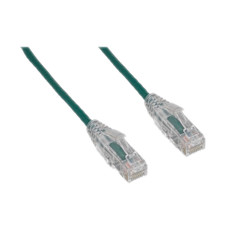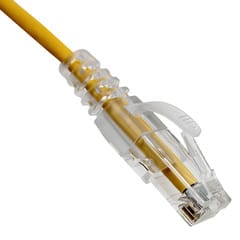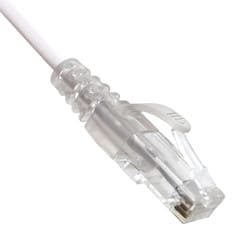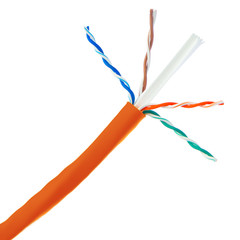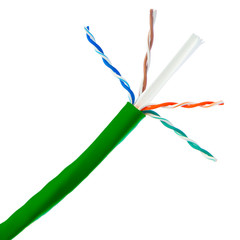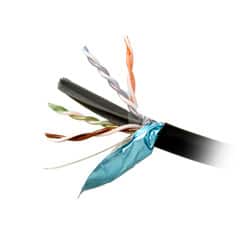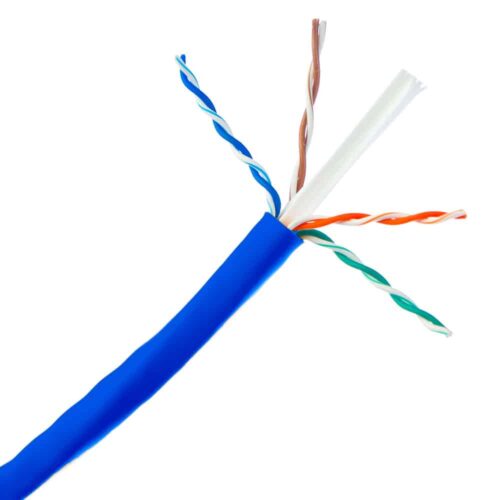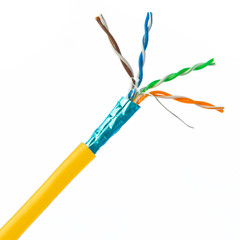-
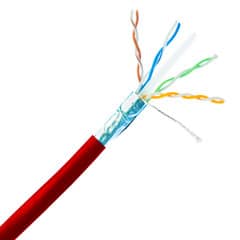 Our red bulk 1000 foot solid Cat6a Shielded Ethernet cable comes in a convenient spool and is ideal for the person looking to make longer permanent network runs during installation/expansion of network infrastructure. Cat6a was developed to achieve maximum distance of 100 meters for full 10-Gigabit network speeds. This robust spec will afford you the extra headroom across your network that Cat6 can not. The 500 Mhz performance is double that of Category 6 and five times the bandwidth capacity of Category 5e. The extra performance is ideal for Power over Ethernet (PoE) and Voice Over Internet Protocol (VoIP) applications where data loss is audibly and visually seen and heard. The latest draft declares a new measurement for Power-Sum Alien Crosstalk to ensure neighboring pairs do not cause disturbance to the other cables. The cable center isolator maintains strict pair separation optimizing NEXT performance. Our Cat6a bulk cable tested for compliance with all EIA/TIA-568-C Category 6a specifications. This particular cable is a red shielded solid cable. Cat6a cable includes a spline and ribbing to help ensure separation between the pairs which limits cross talk. The individual conductors are 23 AWG (American wire gauge) solid pure copper. Pure copper conductors provide the best signal possible. This bulk CAT6a cable will not be able to be crimped onto any connectors. The wires are simply too thick to fit. This cable should be punched down into a CAT6a keystone jack on one end and patch panel on the other end.Part No. 13X6-571NH
Our red bulk 1000 foot solid Cat6a Shielded Ethernet cable comes in a convenient spool and is ideal for the person looking to make longer permanent network runs during installation/expansion of network infrastructure. Cat6a was developed to achieve maximum distance of 100 meters for full 10-Gigabit network speeds. This robust spec will afford you the extra headroom across your network that Cat6 can not. The 500 Mhz performance is double that of Category 6 and five times the bandwidth capacity of Category 5e. The extra performance is ideal for Power over Ethernet (PoE) and Voice Over Internet Protocol (VoIP) applications where data loss is audibly and visually seen and heard. The latest draft declares a new measurement for Power-Sum Alien Crosstalk to ensure neighboring pairs do not cause disturbance to the other cables. The cable center isolator maintains strict pair separation optimizing NEXT performance. Our Cat6a bulk cable tested for compliance with all EIA/TIA-568-C Category 6a specifications. This particular cable is a red shielded solid cable. Cat6a cable includes a spline and ribbing to help ensure separation between the pairs which limits cross talk. The individual conductors are 23 AWG (American wire gauge) solid pure copper. Pure copper conductors provide the best signal possible. This bulk CAT6a cable will not be able to be crimped onto any connectors. The wires are simply too thick to fit. This cable should be punched down into a CAT6a keystone jack on one end and patch panel on the other end.Part No. 13X6-571NH -
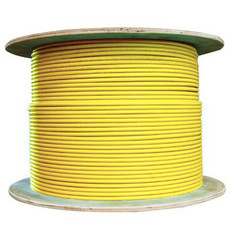 Our yellow bulk 1000 foot solid Cat6a Shielded Ethernet cable comes in a convenient spool and is ideal for the person looking to make longer permanent network runs during installation/expansion of network infrastructure. Cat6a was developed to achieve maximum distance of 100 meters for full 10-Gigabit network speeds. This robust spec will afford you the extra headroom across your network that Cat6 can not. The 500 Mhz performance is double that of Category 6 and five times the bandwidth capacity of Category 5e. The extra performance is ideal for Power over Ethernet (PoE) and Voice Over Internet Protocol (VoIP) applications where data loss is audibly and visually seen and heard. The latest draft declares a new measurement for Power-Sum Alien Crosstalk to ensure neighboring pairs do not cause disturbance to the other cables. The cable center isolator maintains strict pair separation optimizing NEXT performance. Our Cat6a bulk cable tested for compliance with all EIA/TIA-568-C Category 6a specifications. This particular cable is a yellow shielded solid cable. Cat6a cable includes a spline and ribbing to help ensure separation between the pairs which limits cross talk. The individual conductors are 23 AWG (American wire gauge) solid pure copper. Pure copper conductors provide the best signal possible. This bulk CAT6a cable will not be able to be crimped onto any connectors. The wires are simply too thick to fit. This cable should be punched down into a CAT6a keystone jack on one end and patch panel on the other end.Part No. 13X6-581NH
Our yellow bulk 1000 foot solid Cat6a Shielded Ethernet cable comes in a convenient spool and is ideal for the person looking to make longer permanent network runs during installation/expansion of network infrastructure. Cat6a was developed to achieve maximum distance of 100 meters for full 10-Gigabit network speeds. This robust spec will afford you the extra headroom across your network that Cat6 can not. The 500 Mhz performance is double that of Category 6 and five times the bandwidth capacity of Category 5e. The extra performance is ideal for Power over Ethernet (PoE) and Voice Over Internet Protocol (VoIP) applications where data loss is audibly and visually seen and heard. The latest draft declares a new measurement for Power-Sum Alien Crosstalk to ensure neighboring pairs do not cause disturbance to the other cables. The cable center isolator maintains strict pair separation optimizing NEXT performance. Our Cat6a bulk cable tested for compliance with all EIA/TIA-568-C Category 6a specifications. This particular cable is a yellow shielded solid cable. Cat6a cable includes a spline and ribbing to help ensure separation between the pairs which limits cross talk. The individual conductors are 23 AWG (American wire gauge) solid pure copper. Pure copper conductors provide the best signal possible. This bulk CAT6a cable will not be able to be crimped onto any connectors. The wires are simply too thick to fit. This cable should be punched down into a CAT6a keystone jack on one end and patch panel on the other end.Part No. 13X6-581NH -
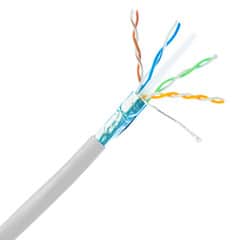 Our white bulk 1000 foot solid Cat6a Shielded Ethernet cable comes in a convenient spool and is ideal for the person looking to make longer permanent network runs during installation/expansion of network infrastructure. Cat6a was developed to achieve maximum distance of 100 meters for full 10-Gigabit network speeds. This robust spec will afford you the extra headroom across your network that Cat6 can not. The 500 Mhz performance is double that of Category 6 and five times the bandwidth capacity of Category 5e. The extra performance is ideal for Power over Ethernet (PoE) and Voice Over Internet Protocol (VoIP) applications where data loss is audibly and visually seen and heard. The latest draft declares a new measurement for Power-Sum Alien Crosstalk to ensure neighboring pairs do not cause disturbance to the other cables. The cable center isolator maintains strict pair separation optimizing NEXT performance. Our Cat6a bulk cable tested for compliance with all EIA/TIA-568-C Category 6a specifications. This particular cable is a white shielded solid cable. Cat6a cable includes a spline and ribbing to help ensure separation between the pairs which limits cross talk. The individual conductors are 23 AWG (American wire gauge) solid pure copper. Pure copper conductors provide the best signal possible. This bulk CAT6a cable will not be able to be crimped onto any connectors. The wires are simply too thick to fit. This cable should be punched down into a CAT6a keystone jack on one end and patch panel on the other end.Part No. 13X6-591NH
Our white bulk 1000 foot solid Cat6a Shielded Ethernet cable comes in a convenient spool and is ideal for the person looking to make longer permanent network runs during installation/expansion of network infrastructure. Cat6a was developed to achieve maximum distance of 100 meters for full 10-Gigabit network speeds. This robust spec will afford you the extra headroom across your network that Cat6 can not. The 500 Mhz performance is double that of Category 6 and five times the bandwidth capacity of Category 5e. The extra performance is ideal for Power over Ethernet (PoE) and Voice Over Internet Protocol (VoIP) applications where data loss is audibly and visually seen and heard. The latest draft declares a new measurement for Power-Sum Alien Crosstalk to ensure neighboring pairs do not cause disturbance to the other cables. The cable center isolator maintains strict pair separation optimizing NEXT performance. Our Cat6a bulk cable tested for compliance with all EIA/TIA-568-C Category 6a specifications. This particular cable is a white shielded solid cable. Cat6a cable includes a spline and ribbing to help ensure separation between the pairs which limits cross talk. The individual conductors are 23 AWG (American wire gauge) solid pure copper. Pure copper conductors provide the best signal possible. This bulk CAT6a cable will not be able to be crimped onto any connectors. The wires are simply too thick to fit. This cable should be punched down into a CAT6a keystone jack on one end and patch panel on the other end.Part No. 13X6-591NH -
 This 6 Inch Cat6a Gray Slim Ethernet Patch Cable comes with a Snagless/Molded Boot and is the perfect solution to all of your Cat6a needs. The smaller diameter makes for a slimmer, more flexible cable that will fit well into cluttered data centers and other places where space is tight. With speeds up to 500 MHz, this cable twice as fast as regular Cat6. Our Cat6a patch cables are tested for compliance with all EIA/TIA-568-C Category 6a specifications.Part No. 13X6-62100.5
This 6 Inch Cat6a Gray Slim Ethernet Patch Cable comes with a Snagless/Molded Boot and is the perfect solution to all of your Cat6a needs. The smaller diameter makes for a slimmer, more flexible cable that will fit well into cluttered data centers and other places where space is tight. With speeds up to 500 MHz, this cable twice as fast as regular Cat6. Our Cat6a patch cables are tested for compliance with all EIA/TIA-568-C Category 6a specifications.Part No. 13X6-62100.5 -
 This 2ft Cat6a Gray Slim Ethernet Patch Cable comes with a Snagless/Molded Boot and is the perfect solution to all of your Cat6a needs. The smaller diameter makes for a slimmer, more flexible cable that will fit well into cluttered data centers and other places where space is tight. With speeds up to 500 MHz, this cable twice as fast as regular Cat6. Our Cat6a patch cables are tested for compliance with all EIA/TIA-568-C Category 6a specifications.Part No. 13X6-62102
This 2ft Cat6a Gray Slim Ethernet Patch Cable comes with a Snagless/Molded Boot and is the perfect solution to all of your Cat6a needs. The smaller diameter makes for a slimmer, more flexible cable that will fit well into cluttered data centers and other places where space is tight. With speeds up to 500 MHz, this cable twice as fast as regular Cat6. Our Cat6a patch cables are tested for compliance with all EIA/TIA-568-C Category 6a specifications.Part No. 13X6-62102 -
 This 5ft Cat6a Gray Slim Ethernet Patch Cable comes with a Snagless/Molded Boot and is the perfect solution to all of your Cat6a needs. The smaller diameter makes for a slimmer, more flexible cable that will fit well into cluttered data centers and other places where space is tight. With speeds up to 500 MHz, this cable twice as fast as regular Cat6. Our Cat6a patch cables are tested for compliance with all EIA/TIA-568-C Category 6a specifications.Part No. 13X6-62105
This 5ft Cat6a Gray Slim Ethernet Patch Cable comes with a Snagless/Molded Boot and is the perfect solution to all of your Cat6a needs. The smaller diameter makes for a slimmer, more flexible cable that will fit well into cluttered data centers and other places where space is tight. With speeds up to 500 MHz, this cable twice as fast as regular Cat6. Our Cat6a patch cables are tested for compliance with all EIA/TIA-568-C Category 6a specifications.Part No. 13X6-62105 -
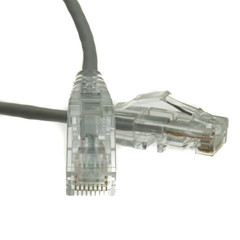 This 7ft Cat6a Gray Slim Ethernet Patch Cable comes with a Snagless/Molded Boot and is the perfect solution to all of your Cat6a needs. The smaller diameter makes for a slimmer, more flexible cable that will fit well into cluttered data centers and other places where space is tight. With speeds up to 500 MHz, this cable twice as fast as regular Cat6. Our Cat6a patch cables are tested for compliance with all EIA/TIA-568-C Category 6a specifications.Part No. 13X6-62107
This 7ft Cat6a Gray Slim Ethernet Patch Cable comes with a Snagless/Molded Boot and is the perfect solution to all of your Cat6a needs. The smaller diameter makes for a slimmer, more flexible cable that will fit well into cluttered data centers and other places where space is tight. With speeds up to 500 MHz, this cable twice as fast as regular Cat6. Our Cat6a patch cables are tested for compliance with all EIA/TIA-568-C Category 6a specifications.Part No. 13X6-62107 -
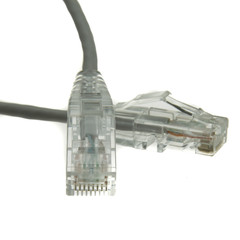 This 10ft Cat6a Gray Slim Ethernet Patch Cable comes with a Snagless/Molded Boot and is the perfect solution to all of your Cat6a needs. The smaller diameter makes for a slimmer, more flexible cable that will fit well into cluttered data centers and other places where space is tight. With speeds up to 500 MHz, this cable twice as fast as regular Cat6. Our Cat6a patch cables are tested for compliance with all EIA/TIA-568-C Category 6a specifications.Part No. 13X6-62110
This 10ft Cat6a Gray Slim Ethernet Patch Cable comes with a Snagless/Molded Boot and is the perfect solution to all of your Cat6a needs. The smaller diameter makes for a slimmer, more flexible cable that will fit well into cluttered data centers and other places where space is tight. With speeds up to 500 MHz, this cable twice as fast as regular Cat6. Our Cat6a patch cables are tested for compliance with all EIA/TIA-568-C Category 6a specifications.Part No. 13X6-62110 -
 This 20ft Cat6a Gray Slim Ethernet Patch Cable comes with a Snagless/Molded Boot and is the perfect solution to all of your Cat6a needs. The smaller diameter makes for a slimmer, more flexible cable that will fit well into cluttered data centers and other places where space is tight. With speeds up to 500 MHz, this cable twice as fast as regular Cat6. Our Cat6a patch cables are tested for compliance with all EIA/TIA-568-C Category 6a specifications.Part No. 13X6-62120
This 20ft Cat6a Gray Slim Ethernet Patch Cable comes with a Snagless/Molded Boot and is the perfect solution to all of your Cat6a needs. The smaller diameter makes for a slimmer, more flexible cable that will fit well into cluttered data centers and other places where space is tight. With speeds up to 500 MHz, this cable twice as fast as regular Cat6. Our Cat6a patch cables are tested for compliance with all EIA/TIA-568-C Category 6a specifications.Part No. 13X6-62120 -
 This 25ft Cat6a Gray Slim Ethernet Patch Cable comes with a Snagless/Molded Boot and is the perfect solution to all of your Cat6a needs. The smaller diameter makes for a slimmer, more flexible cable that will fit well into cluttered data centers and other places where space is tight. With speeds up to 500 MHz, this cable twice as fast as regular Cat6. Our Cat6a patch cables are tested for compliance with all EIA/TIA-568-C Category 6a specifications.Part No. 13X6-62125
This 25ft Cat6a Gray Slim Ethernet Patch Cable comes with a Snagless/Molded Boot and is the perfect solution to all of your Cat6a needs. The smaller diameter makes for a slimmer, more flexible cable that will fit well into cluttered data centers and other places where space is tight. With speeds up to 500 MHz, this cable twice as fast as regular Cat6. Our Cat6a patch cables are tested for compliance with all EIA/TIA-568-C Category 6a specifications.Part No. 13X6-62125 -
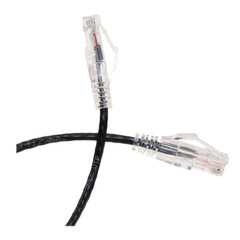 This 6 Inch Cat6a Black Slim Ethernet Patch Cable comes with a Snagless/Molded Boot and is the perfect solution to all of your Cat6a needs. The smaller diameter makes for a slimmer, more flexible cable that will fit well into cluttered data centers and other places where space is tight. With speeds up to 500 MHz, this cable twice as fast as regular Cat6. Our Cat6a patch cables are tested for compliance with all EIA/TIA-568-C Category 6a specifications.Part No. 13X6-62200.5
This 6 Inch Cat6a Black Slim Ethernet Patch Cable comes with a Snagless/Molded Boot and is the perfect solution to all of your Cat6a needs. The smaller diameter makes for a slimmer, more flexible cable that will fit well into cluttered data centers and other places where space is tight. With speeds up to 500 MHz, this cable twice as fast as regular Cat6. Our Cat6a patch cables are tested for compliance with all EIA/TIA-568-C Category 6a specifications.Part No. 13X6-62200.5 -
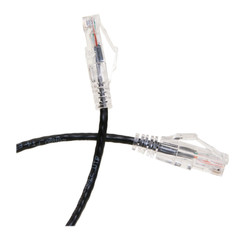 This 1ft Cat6a Black Slim Ethernet Patch Cable comes with a Snagless/Molded Boot and is the perfect solution to all of your Cat6a needs. The smaller diameter makes for a slimmer, more flexible cable that will fit well into cluttered data centers and other places where space is tight. With speeds up to 500 MHz, this cable twice as fast as regular Cat6. Our Cat6a patch cables are tested for compliance with all EIA/TIA-568-C Category 6a specifications.Part No. 13X6-62201
This 1ft Cat6a Black Slim Ethernet Patch Cable comes with a Snagless/Molded Boot and is the perfect solution to all of your Cat6a needs. The smaller diameter makes for a slimmer, more flexible cable that will fit well into cluttered data centers and other places where space is tight. With speeds up to 500 MHz, this cable twice as fast as regular Cat6. Our Cat6a patch cables are tested for compliance with all EIA/TIA-568-C Category 6a specifications.Part No. 13X6-62201 -
 This 3ft Cat6a Black Slim Ethernet Patch Cable comes with a Snagless/Molded Boot and is the perfect solution to all of your Cat6a needs. The smaller diameter makes for a slimmer, more flexible cable that will fit well into cluttered data centers and other places where space is tight. With speeds up to 500 MHz, this cable twice as fast as regular Cat6. Our Cat6a patch cables are tested for compliance with all EIA/TIA-568-C Category 6a specifications.Part No. 13X6-62203
This 3ft Cat6a Black Slim Ethernet Patch Cable comes with a Snagless/Molded Boot and is the perfect solution to all of your Cat6a needs. The smaller diameter makes for a slimmer, more flexible cable that will fit well into cluttered data centers and other places where space is tight. With speeds up to 500 MHz, this cable twice as fast as regular Cat6. Our Cat6a patch cables are tested for compliance with all EIA/TIA-568-C Category 6a specifications.Part No. 13X6-62203 -
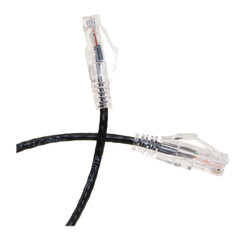 This 5ft Cat6a Black Slim Ethernet Patch Cable comes with a Snagless/Molded Boot and is the perfect solution to all of your Cat6a needs. The smaller diameter makes for a slimmer, more flexible cable that will fit well into cluttered data centers and other places where space is tight. With speeds up to 500 MHz, this cable twice as fast as regular Cat6. Our Cat6a patch cables are tested for compliance with all EIA/TIA-568-C Category 6a specifications.Part No. 13X6-62205
This 5ft Cat6a Black Slim Ethernet Patch Cable comes with a Snagless/Molded Boot and is the perfect solution to all of your Cat6a needs. The smaller diameter makes for a slimmer, more flexible cable that will fit well into cluttered data centers and other places where space is tight. With speeds up to 500 MHz, this cable twice as fast as regular Cat6. Our Cat6a patch cables are tested for compliance with all EIA/TIA-568-C Category 6a specifications.Part No. 13X6-62205 -
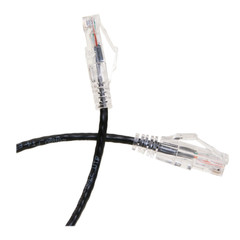 This 7ft Cat6a Black Slim Ethernet Patch Cable comes with a Snagless/Molded Boot and is the perfect solution to all of your Cat6a needs. The smaller diameter makes for a slimmer, more flexible cable that will fit well into cluttered data centers and other places where space is tight. With speeds up to 500 MHz, this cable twice as fast as regular Cat6. Our Cat6a patch cables are tested for compliance with all EIA/TIA-568-C Category 6a specifications.Part No. 13X6-62207
This 7ft Cat6a Black Slim Ethernet Patch Cable comes with a Snagless/Molded Boot and is the perfect solution to all of your Cat6a needs. The smaller diameter makes for a slimmer, more flexible cable that will fit well into cluttered data centers and other places where space is tight. With speeds up to 500 MHz, this cable twice as fast as regular Cat6. Our Cat6a patch cables are tested for compliance with all EIA/TIA-568-C Category 6a specifications.Part No. 13X6-62207 -
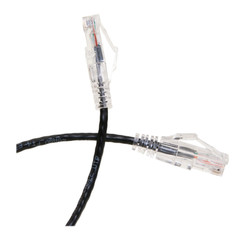 This 10ft Cat6a Black Slim Ethernet Patch Cable comes with a Snagless/Molded Boot and is the perfect solution to all of your Cat6a needs. The smaller diameter makes for a slimmer, more flexible cable that will fit well into cluttered data centers and other places where space is tight. With speeds up to 500 MHz, this cable twice as fast as regular Cat6. Our Cat6a patch cables are tested for compliance with all EIA/TIA-568-C Category 6a specifications.Part No. 13X6-62210
This 10ft Cat6a Black Slim Ethernet Patch Cable comes with a Snagless/Molded Boot and is the perfect solution to all of your Cat6a needs. The smaller diameter makes for a slimmer, more flexible cable that will fit well into cluttered data centers and other places where space is tight. With speeds up to 500 MHz, this cable twice as fast as regular Cat6. Our Cat6a patch cables are tested for compliance with all EIA/TIA-568-C Category 6a specifications.Part No. 13X6-62210 -
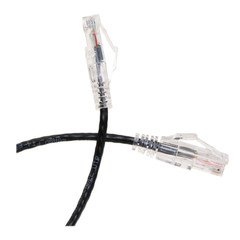 This 15ft Cat6a Black Slim Ethernet Patch Cable comes with a Snagless/Molded Boot and is the perfect solution to all of your Cat6a needs. The smaller diameter makes for a slimmer, more flexible cable that will fit well into cluttered data centers and other places where space is tight. With speeds up to 500 MHz, this cable twice as fast as regular Cat6. Our Cat6a patch cables are tested for compliance with all EIA/TIA-568-C Category 6a specifications.Part No. 13X6-62215
This 15ft Cat6a Black Slim Ethernet Patch Cable comes with a Snagless/Molded Boot and is the perfect solution to all of your Cat6a needs. The smaller diameter makes for a slimmer, more flexible cable that will fit well into cluttered data centers and other places where space is tight. With speeds up to 500 MHz, this cable twice as fast as regular Cat6. Our Cat6a patch cables are tested for compliance with all EIA/TIA-568-C Category 6a specifications.Part No. 13X6-62215 -
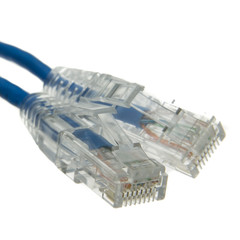 This 6 inch Cat6a Blue Slim Ethernet Patch Cable is perfect for installations that are in a tight-spot, and require a thinner cable than the typical thick Cat6a cable. Cat6a is the fastest Ethernet cable available on the market that meets TIA/EIA standards. The 500 Mhz performance is double that of Category 6 and five times the bandwidth capacity of Category 5e. The extra performance is ideal for Power over Ethernet (PoE) and Voice Over Internet Protocol (VoIP) applications where data loss can be seen and heard. Our Cat6a patch cables are tested for compliance with all EIA/TIA-568-C Category 6 specifications.Part No. 13X6-66100.5
This 6 inch Cat6a Blue Slim Ethernet Patch Cable is perfect for installations that are in a tight-spot, and require a thinner cable than the typical thick Cat6a cable. Cat6a is the fastest Ethernet cable available on the market that meets TIA/EIA standards. The 500 Mhz performance is double that of Category 6 and five times the bandwidth capacity of Category 5e. The extra performance is ideal for Power over Ethernet (PoE) and Voice Over Internet Protocol (VoIP) applications where data loss can be seen and heard. Our Cat6a patch cables are tested for compliance with all EIA/TIA-568-C Category 6 specifications.Part No. 13X6-66100.5 -
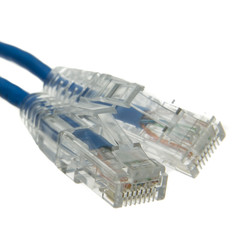 This 1ft Cat6a Blue Slim Ethernet Patch Cable is perfect for installations that are in a tight-spot, and require a thinner cable than the typical thick Cat6a cable. Cat6a is the fastest Ethernet cable available on the market that meets TIA/EIA standards. The 500 Mhz performance is double that of Category 6 and five times the bandwidth capacity of Category 5e. The extra performance is ideal for Power over Ethernet (PoE) and Voice Over Internet Protocol (VoIP) applications where data loss can be seen and heard. Our Cat6a patch cables are tested for compliance with all EIA/TIA-568-C Category 6 specifications.Part No. 13X6-66101
This 1ft Cat6a Blue Slim Ethernet Patch Cable is perfect for installations that are in a tight-spot, and require a thinner cable than the typical thick Cat6a cable. Cat6a is the fastest Ethernet cable available on the market that meets TIA/EIA standards. The 500 Mhz performance is double that of Category 6 and five times the bandwidth capacity of Category 5e. The extra performance is ideal for Power over Ethernet (PoE) and Voice Over Internet Protocol (VoIP) applications where data loss can be seen and heard. Our Cat6a patch cables are tested for compliance with all EIA/TIA-568-C Category 6 specifications.Part No. 13X6-66101 -
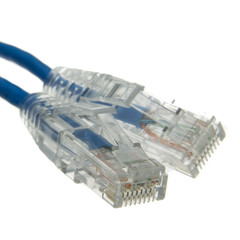 This 2ft Cat6a Blue Slim Ethernet Patch Cable is perfect for installations that are in a tight-spot, and require a thinner cable than the typical thick Cat6a cable. Cat6a is the fastest Ethernet cable available on the market that meets TIA/EIA standards. The 500 Mhz performance is double that of Category 6 and five times the bandwidth capacity of Category 5e. The extra performance is ideal for Power over Ethernet (PoE) and Voice Over Internet Protocol (VoIP) applications where data loss can be seen and heard. Our Cat6a patch cables are tested for compliance with all EIA/TIA-568-C Category 6 specifications.Part No. 13X6-66102
This 2ft Cat6a Blue Slim Ethernet Patch Cable is perfect for installations that are in a tight-spot, and require a thinner cable than the typical thick Cat6a cable. Cat6a is the fastest Ethernet cable available on the market that meets TIA/EIA standards. The 500 Mhz performance is double that of Category 6 and five times the bandwidth capacity of Category 5e. The extra performance is ideal for Power over Ethernet (PoE) and Voice Over Internet Protocol (VoIP) applications where data loss can be seen and heard. Our Cat6a patch cables are tested for compliance with all EIA/TIA-568-C Category 6 specifications.Part No. 13X6-66102 -
 This 3ft Cat6a Blue Slim Ethernet Patch Cable is perfect for installations that are in a tight-spot, and require a thinner cable than the typical thick Cat6a cable. Cat6a is the fastest Ethernet cable available on the market that meets TIA/EIA standards. The 500 Mhz performance is double that of Category 6 and five times the bandwidth capacity of Category 5e. The extra performance is ideal for Power over Ethernet (PoE) and Voice Over Internet Protocol (VoIP) applications where data loss can be seen and heard. Our Cat6a patch cables are tested for compliance with all EIA/TIA-568-C Category 6 specifications.Part No. 13X6-66103
This 3ft Cat6a Blue Slim Ethernet Patch Cable is perfect for installations that are in a tight-spot, and require a thinner cable than the typical thick Cat6a cable. Cat6a is the fastest Ethernet cable available on the market that meets TIA/EIA standards. The 500 Mhz performance is double that of Category 6 and five times the bandwidth capacity of Category 5e. The extra performance is ideal for Power over Ethernet (PoE) and Voice Over Internet Protocol (VoIP) applications where data loss can be seen and heard. Our Cat6a patch cables are tested for compliance with all EIA/TIA-568-C Category 6 specifications.Part No. 13X6-66103 -
 This 5ft Cat6a Blue Slim Ethernet Patch Cable is perfect for installations that are in a tight-spot, and require a thinner cable than the typical thick Cat6a cable. Cat6a is the fastest Ethernet cable available on the market that meets TIA/EIA standards. The 500 Mhz performance is double that of Category 6 and five times the bandwidth capacity of Category 5e. The extra performance is ideal for Power over Ethernet (PoE) and Voice Over Internet Protocol (VoIP) applications where data loss can be seen and heard. Our Cat6a patch cables are tested for compliance with all EIA/TIA-568-C Category 6 specifications.Part No. 13X6-66105
This 5ft Cat6a Blue Slim Ethernet Patch Cable is perfect for installations that are in a tight-spot, and require a thinner cable than the typical thick Cat6a cable. Cat6a is the fastest Ethernet cable available on the market that meets TIA/EIA standards. The 500 Mhz performance is double that of Category 6 and five times the bandwidth capacity of Category 5e. The extra performance is ideal for Power over Ethernet (PoE) and Voice Over Internet Protocol (VoIP) applications where data loss can be seen and heard. Our Cat6a patch cables are tested for compliance with all EIA/TIA-568-C Category 6 specifications.Part No. 13X6-66105 -
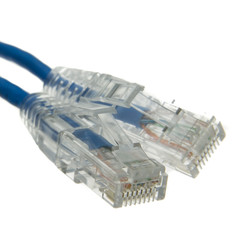 This 7ft Cat6a Blue Slim Ethernet Patch Cable is perfect for installations that are in a tight-spot, and require a thinner cable than the typical thick Cat6a cable. Cat6a is the fastest Ethernet cable available on the market that meets TIA/EIA standards. The 500 Mhz performance is double that of Category 6 and five times the bandwidth capacity of Category 5e. The extra performance is ideal for Power over Ethernet (PoE) and Voice Over Internet Protocol (VoIP) applications where data loss can be seen and heard. Our Cat6a patch cables are tested for compliance with all EIA/TIA-568-C Category 6 specifications.Part No. 13X6-66107
This 7ft Cat6a Blue Slim Ethernet Patch Cable is perfect for installations that are in a tight-spot, and require a thinner cable than the typical thick Cat6a cable. Cat6a is the fastest Ethernet cable available on the market that meets TIA/EIA standards. The 500 Mhz performance is double that of Category 6 and five times the bandwidth capacity of Category 5e. The extra performance is ideal for Power over Ethernet (PoE) and Voice Over Internet Protocol (VoIP) applications where data loss can be seen and heard. Our Cat6a patch cables are tested for compliance with all EIA/TIA-568-C Category 6 specifications.Part No. 13X6-66107 -
 This 15ft Cat6a Blue Slim Ethernet Patch Cable is perfect for installations that are in a tight-spot, and require a thinner cable than the typical thick Cat6a cable. Cat6a is the fastest Ethernet cable available on the market that meets TIA/EIA standards. The 500 Mhz performance is double that of Category 6 and five times the bandwidth capacity of Category 5e. The extra performance is ideal for Power over Ethernet (PoE) and Voice Over Internet Protocol (VoIP) applications where data loss can be seen and heard. Our Cat6a patch cables are tested for compliance with all EIA/TIA-568-C Category 6 specifications. Snagless/Molded BootPart No. 13X6-66115
This 15ft Cat6a Blue Slim Ethernet Patch Cable is perfect for installations that are in a tight-spot, and require a thinner cable than the typical thick Cat6a cable. Cat6a is the fastest Ethernet cable available on the market that meets TIA/EIA standards. The 500 Mhz performance is double that of Category 6 and five times the bandwidth capacity of Category 5e. The extra performance is ideal for Power over Ethernet (PoE) and Voice Over Internet Protocol (VoIP) applications where data loss can be seen and heard. Our Cat6a patch cables are tested for compliance with all EIA/TIA-568-C Category 6 specifications. Snagless/Molded BootPart No. 13X6-66115 -
 This 6 Inch Cat6a Red Slim Ethernet Patch Cable comes with a Snagless/Molded Boot and is the perfect solution to all of your Cat6a needs. The smaller diameter makes for a slimmer, more flexible cable that will fit well into cluttered data centers and other places where space is tight. With speeds up to 500 MHz, this cable twice as fast as regular Cat6. Our Cat6a patch cables are tested for compliance with all EIA/TIA-568-C Category 6a specifications.Part No. 13X6-67100.5
This 6 Inch Cat6a Red Slim Ethernet Patch Cable comes with a Snagless/Molded Boot and is the perfect solution to all of your Cat6a needs. The smaller diameter makes for a slimmer, more flexible cable that will fit well into cluttered data centers and other places where space is tight. With speeds up to 500 MHz, this cable twice as fast as regular Cat6. Our Cat6a patch cables are tested for compliance with all EIA/TIA-568-C Category 6a specifications.Part No. 13X6-67100.5 -
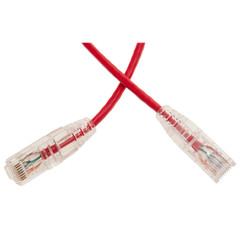 This 1ft Cat6a Red Slim Ethernet Patch Cable comes with a Snagless/Molded Boot and is the perfect solution to all of your Cat6a needs. The smaller diameter makes for a slimmer, more flexible cable that will fit well into cluttered data centers and other places where space is tight. With speeds up to 500 MHz, this cable twice as fast as regular Cat6. Our Cat6a patch cables are tested for compliance with all EIA/TIA-568-C Category 6a specifications.Part No. 13X6-67101
This 1ft Cat6a Red Slim Ethernet Patch Cable comes with a Snagless/Molded Boot and is the perfect solution to all of your Cat6a needs. The smaller diameter makes for a slimmer, more flexible cable that will fit well into cluttered data centers and other places where space is tight. With speeds up to 500 MHz, this cable twice as fast as regular Cat6. Our Cat6a patch cables are tested for compliance with all EIA/TIA-568-C Category 6a specifications.Part No. 13X6-67101 -
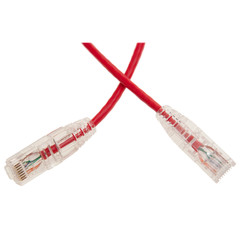 This 3ft Cat6a Red Slim Ethernet Patch Cable comes with a Snagless/Molded Boot and is the perfect solution to all of your Cat6a needs. The smaller diameter makes for a slimmer, more flexible cable that will fit well into cluttered data centers and other places where space is tight. With speeds up to 500 MHz, this cable twice as fast as regular Cat6. Our Cat6a patch cables are tested for compliance with all EIA/TIA-568-C Category 6a specifications.Part No. 13X6-67103
This 3ft Cat6a Red Slim Ethernet Patch Cable comes with a Snagless/Molded Boot and is the perfect solution to all of your Cat6a needs. The smaller diameter makes for a slimmer, more flexible cable that will fit well into cluttered data centers and other places where space is tight. With speeds up to 500 MHz, this cable twice as fast as regular Cat6. Our Cat6a patch cables are tested for compliance with all EIA/TIA-568-C Category 6a specifications.Part No. 13X6-67103 -
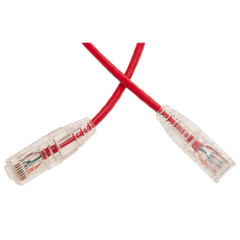 This 5ft Cat6a Red Slim Ethernet Patch Cable comes with a Snagless/Molded Boot and is the perfect solution to all of your Cat6a needs. The smaller diameter makes for a slimmer, more flexible cable that will fit well into cluttered data centers and other places where space is tight. With speeds up to 500 MHz, this cable twice as fast as regular Cat6. Our Cat6a patch cables are tested for compliance with all EIA/TIA-568-C Category 6a specifications.Part No. 13X6-67105
This 5ft Cat6a Red Slim Ethernet Patch Cable comes with a Snagless/Molded Boot and is the perfect solution to all of your Cat6a needs. The smaller diameter makes for a slimmer, more flexible cable that will fit well into cluttered data centers and other places where space is tight. With speeds up to 500 MHz, this cable twice as fast as regular Cat6. Our Cat6a patch cables are tested for compliance with all EIA/TIA-568-C Category 6a specifications.Part No. 13X6-67105 -
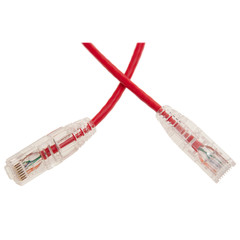 This 7ft Cat6a Red Slim Ethernet Patch Cable comes with a Snagless/Molded Boot and is the perfect solution to all of your Cat6a needs. The smaller diameter makes for a slimmer, more flexible cable that will fit well into cluttered data centers and other places where space is tight. With speeds up to 500 MHz, this cable twice as fast as regular Cat6. Our Cat6a patch cables are tested for compliance with all EIA/TIA-568-C Category 6a specifications.Part No. 13X6-67107
This 7ft Cat6a Red Slim Ethernet Patch Cable comes with a Snagless/Molded Boot and is the perfect solution to all of your Cat6a needs. The smaller diameter makes for a slimmer, more flexible cable that will fit well into cluttered data centers and other places where space is tight. With speeds up to 500 MHz, this cable twice as fast as regular Cat6. Our Cat6a patch cables are tested for compliance with all EIA/TIA-568-C Category 6a specifications.Part No. 13X6-67107 -
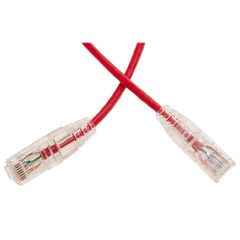 This 10ft Cat6a Red Slim Ethernet Patch Cable comes with a Snagless/Molded Boot and is the perfect solution to all of your Cat6a needs. The smaller diameter makes for a slimmer, more flexible cable that will fit well into cluttered data centers and other places where space is tight. With speeds up to 500 MHz, this cable twice as fast as regular Cat6. Our Cat6a patch cables are tested for compliance with all EIA/TIA-568-C Category 6a specifications.Part No. 13X6-67110
This 10ft Cat6a Red Slim Ethernet Patch Cable comes with a Snagless/Molded Boot and is the perfect solution to all of your Cat6a needs. The smaller diameter makes for a slimmer, more flexible cable that will fit well into cluttered data centers and other places where space is tight. With speeds up to 500 MHz, this cable twice as fast as regular Cat6. Our Cat6a patch cables are tested for compliance with all EIA/TIA-568-C Category 6a specifications.Part No. 13X6-67110 -
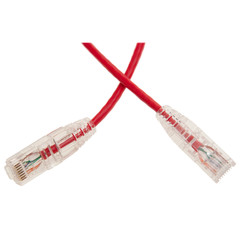 This 15ft Cat6a Red Slim Ethernet Patch Cable comes with a Snagless/Molded Boot and is the perfect solution to all of your Cat6a needs. The smaller diameter makes for a slimmer, more flexible cable that will fit well into cluttered data centers and other places where space is tight. With speeds up to 500 MHz, this cable twice as fast as regular Cat6. Our Cat6a patch cables are tested for compliance with all EIA/TIA-568-C Category 6a specifications.Part No. 13X6-67115
This 15ft Cat6a Red Slim Ethernet Patch Cable comes with a Snagless/Molded Boot and is the perfect solution to all of your Cat6a needs. The smaller diameter makes for a slimmer, more flexible cable that will fit well into cluttered data centers and other places where space is tight. With speeds up to 500 MHz, this cable twice as fast as regular Cat6. Our Cat6a patch cables are tested for compliance with all EIA/TIA-568-C Category 6a specifications.Part No. 13X6-67115 -
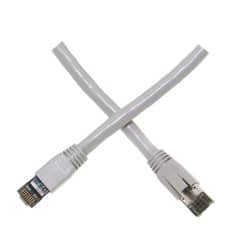 This 6-inch Category 8.1 cable, Class I channel, features a gray PVC jacket, braided outer shield, with four individually mylar foil shielded 24 AWG pure copper pairs as defined in ISO/IEC 11801 and ratified in ANSI/TIA 568-C.2-1. Cat8 cabling was designed primarily for high-speed data centers where switches, servers, and other network hardware are located in close proximity. This newest copper communications cable offers greater flexibility both literally and in distances when compared to QSFP+ and Twinax DAC assemblies which typically cost significantly more and are often much more limited in scope. It has the reach to cover Top-of-Rack and End-of-Row or Middle-of-Row network topologies while delivering 10, 25, and 40 Gigabit data rates over BASE-T technology with RJ45 ends making it a drop-in replacement for Cat6a where rates beyond 10Gb will be needed today or in the future. Cat8 has stricter specifications for noise restriction and crosstalk than any of its predecessors. The individual conductors are 24 AWG (American wire gauge) stranded pure copper. Cat8 patch cables are stranded to improve flexibility. Pure copper conductors provide the best signal possible. Each pair of conductors is shielded with an aluminum mylar foil to reduce, if not eliminate, crosstalk. These cables also have a braided shield, which protects from outside electromagnetic interference.Part No. 13X8-52100.5
This 6-inch Category 8.1 cable, Class I channel, features a gray PVC jacket, braided outer shield, with four individually mylar foil shielded 24 AWG pure copper pairs as defined in ISO/IEC 11801 and ratified in ANSI/TIA 568-C.2-1. Cat8 cabling was designed primarily for high-speed data centers where switches, servers, and other network hardware are located in close proximity. This newest copper communications cable offers greater flexibility both literally and in distances when compared to QSFP+ and Twinax DAC assemblies which typically cost significantly more and are often much more limited in scope. It has the reach to cover Top-of-Rack and End-of-Row or Middle-of-Row network topologies while delivering 10, 25, and 40 Gigabit data rates over BASE-T technology with RJ45 ends making it a drop-in replacement for Cat6a where rates beyond 10Gb will be needed today or in the future. Cat8 has stricter specifications for noise restriction and crosstalk than any of its predecessors. The individual conductors are 24 AWG (American wire gauge) stranded pure copper. Cat8 patch cables are stranded to improve flexibility. Pure copper conductors provide the best signal possible. Each pair of conductors is shielded with an aluminum mylar foil to reduce, if not eliminate, crosstalk. These cables also have a braided shield, which protects from outside electromagnetic interference.Part No. 13X8-52100.5 -
 This 1-foot Category 8.1 cable, Class I channel, features a gray PVC jacket, braided outer shield, with four individually mylar foil shielded 24 AWG pure copper pairs as defined in ISO/IEC 11801 and ratified in ANSI/TIA 568-C.2-1. Cat8 cabling was designed primarily for high-speed data centers where switches, servers, and other network hardware are located in close proximity. This newest copper communications cable offers greater flexibility both literally and in distances when compared to QSFP+ and Twinax DAC assemblies which typically cost significantly more and are often much more limited in scope. It has the reach to cover Top-of-Rack and End-of-Row or Middle-of-Row network topologies while delivering 10, 25, and 40 Gigabit data rates over BASE-T technology with RJ45 ends making it a drop-in replacement for Cat6a where rates beyond 10Gb will be needed today or in the future. Cat8 has stricter specifications for noise restriction and crosstalk than any of its predecessors. The individual conductors are 24 AWG (American wire gauge) stranded pure copper. Cat8 patch cables are stranded to improve flexibility. Pure copper conductors provide the best signal possible. Each pair of conductors is shielded with an aluminum mylar foil to reduce, if not eliminate, crosstalk. These cables also have a braided shield, which protects from outside electromagnetic interference.Part No. 13X8-52101
This 1-foot Category 8.1 cable, Class I channel, features a gray PVC jacket, braided outer shield, with four individually mylar foil shielded 24 AWG pure copper pairs as defined in ISO/IEC 11801 and ratified in ANSI/TIA 568-C.2-1. Cat8 cabling was designed primarily for high-speed data centers where switches, servers, and other network hardware are located in close proximity. This newest copper communications cable offers greater flexibility both literally and in distances when compared to QSFP+ and Twinax DAC assemblies which typically cost significantly more and are often much more limited in scope. It has the reach to cover Top-of-Rack and End-of-Row or Middle-of-Row network topologies while delivering 10, 25, and 40 Gigabit data rates over BASE-T technology with RJ45 ends making it a drop-in replacement for Cat6a where rates beyond 10Gb will be needed today or in the future. Cat8 has stricter specifications for noise restriction and crosstalk than any of its predecessors. The individual conductors are 24 AWG (American wire gauge) stranded pure copper. Cat8 patch cables are stranded to improve flexibility. Pure copper conductors provide the best signal possible. Each pair of conductors is shielded with an aluminum mylar foil to reduce, if not eliminate, crosstalk. These cables also have a braided shield, which protects from outside electromagnetic interference.Part No. 13X8-52101 -
 This 2-foot Category 8.1 cable, Class I channel, features a gray PVC jacket, braided outer shield, with four individually mylar foil shielded 24 AWG pure copper pairs as defined in ISO/IEC 11801 and ratified in ANSI/TIA 568-C.2-1. Cat8 cabling was designed primarily for high-speed data centers where switches, servers, and other network hardware are located in close proximity. This newest copper communications cable offers greater flexibility both literally and in distances when compared to QSFP+ and Twinax DAC assemblies which typically cost significantly more and are often much more limited in scope. It has the reach to cover Top-of-Rack and End-of-Row or Middle-of-Row network topologies while delivering 10, 25, and 40 Gigabit data rates over BASE-T technology with RJ45 ends making it a drop-in replacement for Cat6a where rates beyond 10Gb will be needed today or in the future. Cat8 has stricter specifications for noise restriction and crosstalk than any of its predecessors. The individual conductors are 24 AWG (American wire gauge) stranded pure copper. Cat8 patch cables are stranded to improve flexibility. Pure copper conductors provide the best signal possible. Each pair of conductors is shielded with an aluminum mylar foil to reduce, if not eliminate, crosstalk. These cables also have a braided shield, which protects from outside electromagnetic interference.Part No. 13X8-52102
This 2-foot Category 8.1 cable, Class I channel, features a gray PVC jacket, braided outer shield, with four individually mylar foil shielded 24 AWG pure copper pairs as defined in ISO/IEC 11801 and ratified in ANSI/TIA 568-C.2-1. Cat8 cabling was designed primarily for high-speed data centers where switches, servers, and other network hardware are located in close proximity. This newest copper communications cable offers greater flexibility both literally and in distances when compared to QSFP+ and Twinax DAC assemblies which typically cost significantly more and are often much more limited in scope. It has the reach to cover Top-of-Rack and End-of-Row or Middle-of-Row network topologies while delivering 10, 25, and 40 Gigabit data rates over BASE-T technology with RJ45 ends making it a drop-in replacement for Cat6a where rates beyond 10Gb will be needed today or in the future. Cat8 has stricter specifications for noise restriction and crosstalk than any of its predecessors. The individual conductors are 24 AWG (American wire gauge) stranded pure copper. Cat8 patch cables are stranded to improve flexibility. Pure copper conductors provide the best signal possible. Each pair of conductors is shielded with an aluminum mylar foil to reduce, if not eliminate, crosstalk. These cables also have a braided shield, which protects from outside electromagnetic interference.Part No. 13X8-52102 -
 This 3-foot Category 8.1 cable, Class I channel, features a gray PVC jacket, braided outer shield, with four individually mylar foil shielded 24 AWG pure copper pairs as defined in ISO/IEC 11801 and ratified in ANSI/TIA 568-C.2-1. Cat8 cabling was designed primarily for high-speed data centers where switches, servers, and other network hardware are located in close proximity. This newest copper communications cable offers greater flexibility both literally and in distances when compared to QSFP+ and Twinax DAC assemblies which typically cost significantly more and are often much more limited in scope. It has the reach to cover Top-of-Rack and End-of-Row or Middle-of-Row network topologies while delivering 10, 25, and 40 Gigabit data rates over BASE-T technology with RJ45 ends making it a drop-in replacement for Cat6a where rates beyond 10Gb will be needed today or in the future. Cat8 has stricter specifications for noise restriction and crosstalk than any of its predecessors. The individual conductors are 24 AWG (American wire gauge) stranded pure copper. Cat8 patch cables are stranded to improve flexibility. Pure copper conductors provide the best signal possible. Each pair of conductors is shielded with an aluminum mylar foil to reduce, if not eliminate, crosstalk. These cables also have a braided shield, which protects from outside electromagnetic interference.Part No. 13X8-52103
This 3-foot Category 8.1 cable, Class I channel, features a gray PVC jacket, braided outer shield, with four individually mylar foil shielded 24 AWG pure copper pairs as defined in ISO/IEC 11801 and ratified in ANSI/TIA 568-C.2-1. Cat8 cabling was designed primarily for high-speed data centers where switches, servers, and other network hardware are located in close proximity. This newest copper communications cable offers greater flexibility both literally and in distances when compared to QSFP+ and Twinax DAC assemblies which typically cost significantly more and are often much more limited in scope. It has the reach to cover Top-of-Rack and End-of-Row or Middle-of-Row network topologies while delivering 10, 25, and 40 Gigabit data rates over BASE-T technology with RJ45 ends making it a drop-in replacement for Cat6a where rates beyond 10Gb will be needed today or in the future. Cat8 has stricter specifications for noise restriction and crosstalk than any of its predecessors. The individual conductors are 24 AWG (American wire gauge) stranded pure copper. Cat8 patch cables are stranded to improve flexibility. Pure copper conductors provide the best signal possible. Each pair of conductors is shielded with an aluminum mylar foil to reduce, if not eliminate, crosstalk. These cables also have a braided shield, which protects from outside electromagnetic interference.Part No. 13X8-52103 -
 This 10-foot Category 8.1 cable, Class I channel, features a gray PVC jacket, braided outer shield, with four individually mylar foil shielded 24 AWG pure copper pairs as defined in ISO/IEC 11801 and ratified in ANSI/TIA 568-C.2-1. Cat8 cabling was designed primarily for high-speed data centers where switches, servers, and other network hardware are located in close proximity. This newest copper communications cable offers greater flexibility both literally and in distances when compared to QSFP+ and Twinax DAC assemblies which typically cost significantly more and are often much more limited in scope. It has the reach to cover Top-of-Rack and End-of-Row or Middle-of-Row network topologies while delivering 10, 25, and 40 Gigabit data rates over BASE-T technology with RJ45 ends making it a drop-in replacement for Cat6a where rates beyond 10Gb will be needed today or in the future. Cat8 has stricter specifications for noise restriction and crosstalk than any of its predecessors. The individual conductors are 24 AWG (American wire gauge) stranded pure copper. Cat8 patch cables are stranded to improve flexibility. Pure copper conductors provide the best signal possible. Each pair of conductors is shielded with an aluminum mylar foil to reduce, if not eliminate, crosstalk. These cables also have a braided shield, which protects from outside electromagnetic interference.Part No. 13X8-52110
This 10-foot Category 8.1 cable, Class I channel, features a gray PVC jacket, braided outer shield, with four individually mylar foil shielded 24 AWG pure copper pairs as defined in ISO/IEC 11801 and ratified in ANSI/TIA 568-C.2-1. Cat8 cabling was designed primarily for high-speed data centers where switches, servers, and other network hardware are located in close proximity. This newest copper communications cable offers greater flexibility both literally and in distances when compared to QSFP+ and Twinax DAC assemblies which typically cost significantly more and are often much more limited in scope. It has the reach to cover Top-of-Rack and End-of-Row or Middle-of-Row network topologies while delivering 10, 25, and 40 Gigabit data rates over BASE-T technology with RJ45 ends making it a drop-in replacement for Cat6a where rates beyond 10Gb will be needed today or in the future. Cat8 has stricter specifications for noise restriction and crosstalk than any of its predecessors. The individual conductors are 24 AWG (American wire gauge) stranded pure copper. Cat8 patch cables are stranded to improve flexibility. Pure copper conductors provide the best signal possible. Each pair of conductors is shielded with an aluminum mylar foil to reduce, if not eliminate, crosstalk. These cables also have a braided shield, which protects from outside electromagnetic interference.Part No. 13X8-52110 -
 This 25-foot Category 8.1 cable, Class I channel, features a gray PVC jacket, braided outer shield, with four individually mylar foil shielded 24 AWG pure copper pairs as defined in ISO/IEC 11801 and ratified in ANSI/TIA 568-C.2-1. Cat8 cabling was designed primarily for high-speed data centers where switches, servers, and other network hardware are located in close proximity. This newest copper communications cable offers greater flexibility both literally and in distances when compared to QSFP+ and Twinax DAC assemblies which typically cost significantly more and are often much more limited in scope. It has the reach to cover Top-of-Rack and End-of-Row or Middle-of-Row network topologies while delivering 10, 25, and 40 Gigabit data rates over BASE-T technology with RJ45 ends making it a drop-in replacement for Cat6a where rates beyond 10Gb will be needed today or in the future. Cat8 has stricter specifications for noise restriction and crosstalk than any of its predecessors. The individual conductors are 24 AWG (American wire gauge) stranded pure copper. Cat8 patch cables are stranded to improve flexibility. Pure copper conductors provide the best signal possible. Each pair of conductors is shielded with an aluminum mylar foil to reduce, if not eliminate, crosstalk. These cables also have a braided shield, which protects from outside electromagnetic interference.Part No. 13X8-52125
This 25-foot Category 8.1 cable, Class I channel, features a gray PVC jacket, braided outer shield, with four individually mylar foil shielded 24 AWG pure copper pairs as defined in ISO/IEC 11801 and ratified in ANSI/TIA 568-C.2-1. Cat8 cabling was designed primarily for high-speed data centers where switches, servers, and other network hardware are located in close proximity. This newest copper communications cable offers greater flexibility both literally and in distances when compared to QSFP+ and Twinax DAC assemblies which typically cost significantly more and are often much more limited in scope. It has the reach to cover Top-of-Rack and End-of-Row or Middle-of-Row network topologies while delivering 10, 25, and 40 Gigabit data rates over BASE-T technology with RJ45 ends making it a drop-in replacement for Cat6a where rates beyond 10Gb will be needed today or in the future. Cat8 has stricter specifications for noise restriction and crosstalk than any of its predecessors. The individual conductors are 24 AWG (American wire gauge) stranded pure copper. Cat8 patch cables are stranded to improve flexibility. Pure copper conductors provide the best signal possible. Each pair of conductors is shielded with an aluminum mylar foil to reduce, if not eliminate, crosstalk. These cables also have a braided shield, which protects from outside electromagnetic interference.Part No. 13X8-52125 -
 This 50-foot Category 8.1 cable, Class I channel, features a gray PVC jacket, braided outer shield, with four individually mylar foil shielded 24 AWG pure copper pairs as defined in ISO/IEC 11801 and ratified in ANSI/TIA 568-C.2-1. Cat8 cabling was designed primarily for high-speed data centers where switches, servers, and other network hardware are located in close proximity. This newest copper communications cable offers greater flexibility both literally and in distances when compared to QSFP+ and Twinax DAC assemblies which typically cost significantly more and are often much more limited in scope. It has the reach to cover Top-of-Rack and End-of-Row or Middle-of-Row network topologies while delivering 10, 25, and 40 Gigabit data rates over BASE-T technology with RJ45 ends making it a drop-in replacement for Cat6a where rates beyond 10Gb will be needed today or in the future. Cat8 has stricter specifications for noise restriction and crosstalk than any of its predecessors. The individual conductors are 24 AWG (American wire gauge) stranded pure copper. Cat8 patch cables are stranded to improve flexibility. Pure copper conductors provide the best signal possible. Each pair of conductors is shielded with an aluminum mylar foil to reduce, if not eliminate, crosstalk. These cables also have a braided shield, which protects from outside electromagnetic interference.Part No. 13X8-52150
This 50-foot Category 8.1 cable, Class I channel, features a gray PVC jacket, braided outer shield, with four individually mylar foil shielded 24 AWG pure copper pairs as defined in ISO/IEC 11801 and ratified in ANSI/TIA 568-C.2-1. Cat8 cabling was designed primarily for high-speed data centers where switches, servers, and other network hardware are located in close proximity. This newest copper communications cable offers greater flexibility both literally and in distances when compared to QSFP+ and Twinax DAC assemblies which typically cost significantly more and are often much more limited in scope. It has the reach to cover Top-of-Rack and End-of-Row or Middle-of-Row network topologies while delivering 10, 25, and 40 Gigabit data rates over BASE-T technology with RJ45 ends making it a drop-in replacement for Cat6a where rates beyond 10Gb will be needed today or in the future. Cat8 has stricter specifications for noise restriction and crosstalk than any of its predecessors. The individual conductors are 24 AWG (American wire gauge) stranded pure copper. Cat8 patch cables are stranded to improve flexibility. Pure copper conductors provide the best signal possible. Each pair of conductors is shielded with an aluminum mylar foil to reduce, if not eliminate, crosstalk. These cables also have a braided shield, which protects from outside electromagnetic interference.Part No. 13X8-52150 -
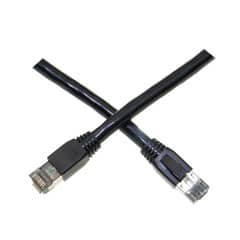 This 6-inch Category 8.1 cable, Class I channel, features a black PVC jacket, braided outer shield, with four individually mylar foil shielded 24 AWG pure copper pairs as defined in ISO/IEC 11801 and ratified in ANSI/TIA 568-C.2-1. Cat8 cabling was designed primarily for high-speed data centers where switches, servers, and other network hardware are located in close proximity. This newest copper communications cable offers greater flexibility both literally and in distances when compared to QSFP+ and Twinax DAC assemblies which typically cost significantly more and are often much more limited in scope. It has the reach to cover Top-of-Rack and End-of-Row or Middle-of-Row network topologies while delivering 10, 25, and 40 Gigabit data rates over BASE-T technology with RJ45 ends making it a drop-in replacement for Cat6a where rates beyond 10Gb will be needed today or in the future. Cat8 has stricter specifications for noise restriction and crosstalk than any of its predecessors. The individual conductors are 24 AWG (American wire gauge) stranded pure copper. Cat8 patch cables are stranded to improve flexibility. Pure copper conductors provide the best signal possible. Each pair of conductors is shielded with an aluminum mylar foil to reduce, if not eliminate, crosstalk. These cables also have a braided shield, which protects from outside electromagnetic interference.Part No. 13X8-52200.5
This 6-inch Category 8.1 cable, Class I channel, features a black PVC jacket, braided outer shield, with four individually mylar foil shielded 24 AWG pure copper pairs as defined in ISO/IEC 11801 and ratified in ANSI/TIA 568-C.2-1. Cat8 cabling was designed primarily for high-speed data centers where switches, servers, and other network hardware are located in close proximity. This newest copper communications cable offers greater flexibility both literally and in distances when compared to QSFP+ and Twinax DAC assemblies which typically cost significantly more and are often much more limited in scope. It has the reach to cover Top-of-Rack and End-of-Row or Middle-of-Row network topologies while delivering 10, 25, and 40 Gigabit data rates over BASE-T technology with RJ45 ends making it a drop-in replacement for Cat6a where rates beyond 10Gb will be needed today or in the future. Cat8 has stricter specifications for noise restriction and crosstalk than any of its predecessors. The individual conductors are 24 AWG (American wire gauge) stranded pure copper. Cat8 patch cables are stranded to improve flexibility. Pure copper conductors provide the best signal possible. Each pair of conductors is shielded with an aluminum mylar foil to reduce, if not eliminate, crosstalk. These cables also have a braided shield, which protects from outside electromagnetic interference.Part No. 13X8-52200.5 -
 This 1-foot Category 8.1 cable, Class I channel, features a black PVC jacket, braided outer shield, with four individually mylar foil shielded 24 AWG pure copper pairs as defined in ISO/IEC 11801 and ratified in ANSI/TIA 568-C.2-1. Cat8 cabling was designed primarily for high-speed data centers where switches, servers, and other network hardware are located in close proximity. This newest copper communications cable offers greater flexibility both literally and in distances when compared to QSFP+ and Twinax DAC assemblies which typically cost significantly more and are often much more limited in scope. It has the reach to cover Top-of-Rack and End-of-Row or Middle-of-Row network topologies while delivering 10, 25, and 40 Gigabit data rates over BASE-T technology with RJ45 ends making it a drop-in replacement for Cat6a where rates beyond 10Gb will be needed today or in the future. Cat8 has stricter specifications for noise restriction and crosstalk than any of its predecessors. The individual conductors are 24 AWG (American wire gauge) stranded pure copper. Cat8 patch cables are stranded to improve flexibility. Pure copper conductors provide the best signal possible. Each pair of conductors is shielded with an aluminum mylar foil to reduce, if not eliminate, crosstalk. These cables also have a braided shield, which protects from outside electromagnetic interference.Part No. 13X8-52201
This 1-foot Category 8.1 cable, Class I channel, features a black PVC jacket, braided outer shield, with four individually mylar foil shielded 24 AWG pure copper pairs as defined in ISO/IEC 11801 and ratified in ANSI/TIA 568-C.2-1. Cat8 cabling was designed primarily for high-speed data centers where switches, servers, and other network hardware are located in close proximity. This newest copper communications cable offers greater flexibility both literally and in distances when compared to QSFP+ and Twinax DAC assemblies which typically cost significantly more and are often much more limited in scope. It has the reach to cover Top-of-Rack and End-of-Row or Middle-of-Row network topologies while delivering 10, 25, and 40 Gigabit data rates over BASE-T technology with RJ45 ends making it a drop-in replacement for Cat6a where rates beyond 10Gb will be needed today or in the future. Cat8 has stricter specifications for noise restriction and crosstalk than any of its predecessors. The individual conductors are 24 AWG (American wire gauge) stranded pure copper. Cat8 patch cables are stranded to improve flexibility. Pure copper conductors provide the best signal possible. Each pair of conductors is shielded with an aluminum mylar foil to reduce, if not eliminate, crosstalk. These cables also have a braided shield, which protects from outside electromagnetic interference.Part No. 13X8-52201 -
 This 2-foot Category 8.1 cable, Class I channel, features a black PVC jacket, braided outer shield, with four individually mylar foil shielded 24 AWG pure copper pairs as defined in ISO/IEC 11801 and ratified in ANSI/TIA 568-C.2-1. Cat8 cabling was designed primarily for high-speed data centers where switches, servers, and other network hardware are located in close proximity. This newest copper communications cable offers greater flexibility both literally and in distances when compared to QSFP+ and Twinax DAC assemblies which typically cost significantly more and are often much more limited in scope. It has the reach to cover Top-of-Rack and End-of-Row or Middle-of-Row network topologies while delivering 10, 25, and 40 Gigabit data rates over BASE-T technology with RJ45 ends making it a drop-in replacement for Cat6a where rates beyond 10Gb will be needed today or in the future. Cat8 has stricter specifications for noise restriction and crosstalk than any of its predecessors. The individual conductors are 24 AWG (American wire gauge) stranded pure copper. Cat8 patch cables are stranded to improve flexibility. Pure copper conductors provide the best signal possible. Each pair of conductors is shielded with an aluminum mylar foil to reduce, if not eliminate, crosstalk. These cables also have a braided shield, which protects from outside electromagnetic interference.Part No. 13X8-52202
This 2-foot Category 8.1 cable, Class I channel, features a black PVC jacket, braided outer shield, with four individually mylar foil shielded 24 AWG pure copper pairs as defined in ISO/IEC 11801 and ratified in ANSI/TIA 568-C.2-1. Cat8 cabling was designed primarily for high-speed data centers where switches, servers, and other network hardware are located in close proximity. This newest copper communications cable offers greater flexibility both literally and in distances when compared to QSFP+ and Twinax DAC assemblies which typically cost significantly more and are often much more limited in scope. It has the reach to cover Top-of-Rack and End-of-Row or Middle-of-Row network topologies while delivering 10, 25, and 40 Gigabit data rates over BASE-T technology with RJ45 ends making it a drop-in replacement for Cat6a where rates beyond 10Gb will be needed today or in the future. Cat8 has stricter specifications for noise restriction and crosstalk than any of its predecessors. The individual conductors are 24 AWG (American wire gauge) stranded pure copper. Cat8 patch cables are stranded to improve flexibility. Pure copper conductors provide the best signal possible. Each pair of conductors is shielded with an aluminum mylar foil to reduce, if not eliminate, crosstalk. These cables also have a braided shield, which protects from outside electromagnetic interference.Part No. 13X8-52202 -
 This 3-foot Category 8.1 cable, Class I channel, features a black PVC jacket, braided outer shield, with four individually mylar foil shielded 24 AWG pure copper pairs as defined in ISO/IEC 11801 and ratified in ANSI/TIA 568-C.2-1. Cat8 cabling was designed primarily for high-speed data centers where switches, servers, and other network hardware are located in close proximity. This newest copper communications cable offers greater flexibility both literally and in distances when compared to QSFP+ and Twinax DAC assemblies which typically cost significantly more and are often much more limited in scope. It has the reach to cover Top-of-Rack and End-of-Row or Middle-of-Row network topologies while delivering 10, 25, and 40 Gigabit data rates over BASE-T technology with RJ45 ends making it a drop-in replacement for Cat6a where rates beyond 10Gb will be needed today or in the future. Cat8 has stricter specifications for noise restriction and crosstalk than any of its predecessors. The individual conductors are 24 AWG (American wire gauge) stranded pure copper. Cat8 patch cables are stranded to improve flexibility. Pure copper conductors provide the best signal possible. Each pair of conductors is shielded with an aluminum mylar foil to reduce, if not eliminate, crosstalk. These cables also have a braided shield, which protects from outside electromagnetic interference.Part No. 13X8-52203
This 3-foot Category 8.1 cable, Class I channel, features a black PVC jacket, braided outer shield, with four individually mylar foil shielded 24 AWG pure copper pairs as defined in ISO/IEC 11801 and ratified in ANSI/TIA 568-C.2-1. Cat8 cabling was designed primarily for high-speed data centers where switches, servers, and other network hardware are located in close proximity. This newest copper communications cable offers greater flexibility both literally and in distances when compared to QSFP+ and Twinax DAC assemblies which typically cost significantly more and are often much more limited in scope. It has the reach to cover Top-of-Rack and End-of-Row or Middle-of-Row network topologies while delivering 10, 25, and 40 Gigabit data rates over BASE-T technology with RJ45 ends making it a drop-in replacement for Cat6a where rates beyond 10Gb will be needed today or in the future. Cat8 has stricter specifications for noise restriction and crosstalk than any of its predecessors. The individual conductors are 24 AWG (American wire gauge) stranded pure copper. Cat8 patch cables are stranded to improve flexibility. Pure copper conductors provide the best signal possible. Each pair of conductors is shielded with an aluminum mylar foil to reduce, if not eliminate, crosstalk. These cables also have a braided shield, which protects from outside electromagnetic interference.Part No. 13X8-52203 -
 This 15-foot Category 8.1 cable, Class I channel, features a black PVC jacket, braided outer shield, with four individually mylar foil shielded 24 AWG pure copper pairs as defined in ISO/IEC 11801 and ratified in ANSI/TIA 568-C.2-1. Cat8 cabling was designed primarily for high-speed data centers where switches, servers, and other network hardware are located in close proximity. This newest copper communications cable offers greater flexibility both literally and in distances when compared to QSFP+ and Twinax DAC assemblies which typically cost significantly more and are often much more limited in scope. It has the reach to cover Top-of-Rack and End-of-Row or Middle-of-Row network topologies while delivering 10, 25, and 40 Gigabit data rates over BASE-T technology with RJ45 ends making it a drop-in replacement for Cat6a where rates beyond 10Gb will be needed today or in the future. Cat8 has stricter specifications for noise restriction and crosstalk than any of its predecessors. The individual conductors are 24 AWG (American wire gauge) stranded pure copper. Cat8 patch cables are stranded to improve flexibility. Pure copper conductors provide the best signal possible. Each pair of conductors is shielded with an aluminum mylar foil to reduce, if not eliminate, crosstalk. These cables also have a braided shield, which protects from outside electromagnetic interference.Part No. 13X8-52215
This 15-foot Category 8.1 cable, Class I channel, features a black PVC jacket, braided outer shield, with four individually mylar foil shielded 24 AWG pure copper pairs as defined in ISO/IEC 11801 and ratified in ANSI/TIA 568-C.2-1. Cat8 cabling was designed primarily for high-speed data centers where switches, servers, and other network hardware are located in close proximity. This newest copper communications cable offers greater flexibility both literally and in distances when compared to QSFP+ and Twinax DAC assemblies which typically cost significantly more and are often much more limited in scope. It has the reach to cover Top-of-Rack and End-of-Row or Middle-of-Row network topologies while delivering 10, 25, and 40 Gigabit data rates over BASE-T technology with RJ45 ends making it a drop-in replacement for Cat6a where rates beyond 10Gb will be needed today or in the future. Cat8 has stricter specifications for noise restriction and crosstalk than any of its predecessors. The individual conductors are 24 AWG (American wire gauge) stranded pure copper. Cat8 patch cables are stranded to improve flexibility. Pure copper conductors provide the best signal possible. Each pair of conductors is shielded with an aluminum mylar foil to reduce, if not eliminate, crosstalk. These cables also have a braided shield, which protects from outside electromagnetic interference.Part No. 13X8-52215 -
 This 25-foot Category 8.1 cable, Class I channel, features a black PVC jacket, braided outer shield, with four individually mylar foil shielded 24 AWG pure copper pairs as defined in ISO/IEC 11801 and ratified in ANSI/TIA 568-C.2-1. Cat8 cabling was designed primarily for high-speed data centers where switches, servers, and other network hardware are located in close proximity. This newest copper communications cable offers greater flexibility both literally and in distances when compared to QSFP+ and Twinax DAC assemblies which typically cost significantly more and are often much more limited in scope. It has the reach to cover Top-of-Rack and End-of-Row or Middle-of-Row network topologies while delivering 10, 25, and 40 Gigabit data rates over BASE-T technology with RJ45 ends making it a drop-in replacement for Cat6a where rates beyond 10Gb will be needed today or in the future. Cat8 has stricter specifications for noise restriction and crosstalk than any of its predecessors. The individual conductors are 24 AWG (American wire gauge) stranded pure copper. Cat8 patch cables are stranded to improve flexibility. Pure copper conductors provide the best signal possible. Each pair of conductors is shielded with an aluminum mylar foil to reduce, if not eliminate, crosstalk. These cables also have a braided shield, which protects from outside electromagnetic interference.Part No. 13X8-52225
This 25-foot Category 8.1 cable, Class I channel, features a black PVC jacket, braided outer shield, with four individually mylar foil shielded 24 AWG pure copper pairs as defined in ISO/IEC 11801 and ratified in ANSI/TIA 568-C.2-1. Cat8 cabling was designed primarily for high-speed data centers where switches, servers, and other network hardware are located in close proximity. This newest copper communications cable offers greater flexibility both literally and in distances when compared to QSFP+ and Twinax DAC assemblies which typically cost significantly more and are often much more limited in scope. It has the reach to cover Top-of-Rack and End-of-Row or Middle-of-Row network topologies while delivering 10, 25, and 40 Gigabit data rates over BASE-T technology with RJ45 ends making it a drop-in replacement for Cat6a where rates beyond 10Gb will be needed today or in the future. Cat8 has stricter specifications for noise restriction and crosstalk than any of its predecessors. The individual conductors are 24 AWG (American wire gauge) stranded pure copper. Cat8 patch cables are stranded to improve flexibility. Pure copper conductors provide the best signal possible. Each pair of conductors is shielded with an aluminum mylar foil to reduce, if not eliminate, crosstalk. These cables also have a braided shield, which protects from outside electromagnetic interference.Part No. 13X8-52225 -
 This 35-foot Category 8.1 cable, Class I channel, features a black PVC jacket, braided outer shield, with four individually mylar foil shielded 24 AWG pure copper pairs as defined in ISO/IEC 11801 and ratified in ANSI/TIA 568-C.2-1. Cat8 cabling was designed primarily for high-speed data centers where switches, servers, and other network hardware are located in close proximity. This newest copper communications cable offers greater flexibility both literally and in distances when compared to QSFP+ and Twinax DAC assemblies which typically cost significantly more and are often much more limited in scope. It has the reach to cover Top-of-Rack and End-of-Row or Middle-of-Row network topologies while delivering 10, 25, and 40 Gigabit data rates over BASE-T technology with RJ45 ends making it a drop-in replacement for Cat6a where rates beyond 10Gb will be needed today or in the future. Cat8 has stricter specifications for noise restriction and crosstalk than any of its predecessors. The individual conductors are 24 AWG (American wire gauge) stranded pure copper. Cat8 patch cables are stranded to improve flexibility. Pure copper conductors provide the best signal possible. Each pair of conductors is shielded with an aluminum mylar foil to reduce, if not eliminate, crosstalk. These cables also have a braided shield, which protects from outside electromagnetic interference.Part No. 13X8-52235
This 35-foot Category 8.1 cable, Class I channel, features a black PVC jacket, braided outer shield, with four individually mylar foil shielded 24 AWG pure copper pairs as defined in ISO/IEC 11801 and ratified in ANSI/TIA 568-C.2-1. Cat8 cabling was designed primarily for high-speed data centers where switches, servers, and other network hardware are located in close proximity. This newest copper communications cable offers greater flexibility both literally and in distances when compared to QSFP+ and Twinax DAC assemblies which typically cost significantly more and are often much more limited in scope. It has the reach to cover Top-of-Rack and End-of-Row or Middle-of-Row network topologies while delivering 10, 25, and 40 Gigabit data rates over BASE-T technology with RJ45 ends making it a drop-in replacement for Cat6a where rates beyond 10Gb will be needed today or in the future. Cat8 has stricter specifications for noise restriction and crosstalk than any of its predecessors. The individual conductors are 24 AWG (American wire gauge) stranded pure copper. Cat8 patch cables are stranded to improve flexibility. Pure copper conductors provide the best signal possible. Each pair of conductors is shielded with an aluminum mylar foil to reduce, if not eliminate, crosstalk. These cables also have a braided shield, which protects from outside electromagnetic interference.Part No. 13X8-52235 -
 This 1-foot Category 8.1 cable, Class I channel, features an orange PVC jacket, braided outer shield, with four individually mylar foil shielded 24 AWG pure copper pairs as defined in ISO/IEC 11801 and ratified in ANSI/TIA 568-C.2-1. Cat8 cabling was designed primarily for high-speed data centers where switches, servers, and other network hardware are located in close proximity. This newest copper communications cable offers greater flexibility both literally and in distances when compared to QSFP+ and Twinax DAC assemblies which typically cost significantly more and are often much more limited in scope. It has the reach to cover Top-of-Rack and End-of-Row or Middle-of-Row network topologies while delivering 10, 25, and 40 Gigabit data rates over BASE-T technology with RJ45 ends making it a drop-in replacement for Cat6a where rates beyond 10Gb will be needed today or in the future. Cat8 has stricter specifications for noise restriction and crosstalk than any of its predecessors. The individual conductors are 24 AWG (American wire gauge) stranded pure copper. Cat8 patch cables are stranded to improve flexibility. Pure copper conductors provide the best signal possible. Each pair of conductors is shielded with an aluminum mylar foil to reduce, if not eliminate, crosstalk. These cables also have a braided shield, which protects from outside electromagnetic interference.Part No. 13X8-53101
This 1-foot Category 8.1 cable, Class I channel, features an orange PVC jacket, braided outer shield, with four individually mylar foil shielded 24 AWG pure copper pairs as defined in ISO/IEC 11801 and ratified in ANSI/TIA 568-C.2-1. Cat8 cabling was designed primarily for high-speed data centers where switches, servers, and other network hardware are located in close proximity. This newest copper communications cable offers greater flexibility both literally and in distances when compared to QSFP+ and Twinax DAC assemblies which typically cost significantly more and are often much more limited in scope. It has the reach to cover Top-of-Rack and End-of-Row or Middle-of-Row network topologies while delivering 10, 25, and 40 Gigabit data rates over BASE-T technology with RJ45 ends making it a drop-in replacement for Cat6a where rates beyond 10Gb will be needed today or in the future. Cat8 has stricter specifications for noise restriction and crosstalk than any of its predecessors. The individual conductors are 24 AWG (American wire gauge) stranded pure copper. Cat8 patch cables are stranded to improve flexibility. Pure copper conductors provide the best signal possible. Each pair of conductors is shielded with an aluminum mylar foil to reduce, if not eliminate, crosstalk. These cables also have a braided shield, which protects from outside electromagnetic interference.Part No. 13X8-53101 -
 This 3-foot Category 8.1 cable, Class I channel, features an orange PVC jacket, braided outer shield, with four individually mylar foil shielded 24 AWG pure copper pairs as defined in ISO/IEC 11801 and ratified in ANSI/TIA 568-C.2-1. Cat8 cabling was designed primarily for high-speed data centers where switches, servers, and other network hardware are located in close proximity. This newest copper communications cable offers greater flexibility both literally and in distances when compared to QSFP+ and Twinax DAC assemblies which typically cost significantly more and are often much more limited in scope. It has the reach to cover Top-of-Rack and End-of-Row or Middle-of-Row network topologies while delivering 10, 25, and 40 Gigabit data rates over BASE-T technology with RJ45 ends making it a drop-in replacement for Cat6a where rates beyond 10Gb will be needed today or in the future. Cat8 has stricter specifications for noise restriction and crosstalk than any of its predecessors. The individual conductors are 24 AWG (American wire gauge) stranded pure copper. Cat8 patch cables are stranded to improve flexibility. Pure copper conductors provide the best signal possible. Each pair of conductors is shielded with an aluminum mylar foil to reduce, if not eliminate, crosstalk. These cables also have a braided shield, which protects from outside electromagnetic interference.Part No. 13X8-53103
This 3-foot Category 8.1 cable, Class I channel, features an orange PVC jacket, braided outer shield, with four individually mylar foil shielded 24 AWG pure copper pairs as defined in ISO/IEC 11801 and ratified in ANSI/TIA 568-C.2-1. Cat8 cabling was designed primarily for high-speed data centers where switches, servers, and other network hardware are located in close proximity. This newest copper communications cable offers greater flexibility both literally and in distances when compared to QSFP+ and Twinax DAC assemblies which typically cost significantly more and are often much more limited in scope. It has the reach to cover Top-of-Rack and End-of-Row or Middle-of-Row network topologies while delivering 10, 25, and 40 Gigabit data rates over BASE-T technology with RJ45 ends making it a drop-in replacement for Cat6a where rates beyond 10Gb will be needed today or in the future. Cat8 has stricter specifications for noise restriction and crosstalk than any of its predecessors. The individual conductors are 24 AWG (American wire gauge) stranded pure copper. Cat8 patch cables are stranded to improve flexibility. Pure copper conductors provide the best signal possible. Each pair of conductors is shielded with an aluminum mylar foil to reduce, if not eliminate, crosstalk. These cables also have a braided shield, which protects from outside electromagnetic interference.Part No. 13X8-53103 -
 This 5-foot Category 8.1 cable, Class I channel, features an orange PVC jacket, braided outer shield, with four individually mylar foil shielded 24 AWG pure copper pairs as defined in ISO/IEC 11801 and ratified in ANSI/TIA 568-C.2-1. Cat8 cabling was designed primarily for high-speed data centers where switches, servers, and other network hardware are located in close proximity. This newest copper communications cable offers greater flexibility both literally and in distances when compared to QSFP+ and Twinax DAC assemblies which typically cost significantly more and are often much more limited in scope. It has the reach to cover Top-of-Rack and End-of-Row or Middle-of-Row network topologies while delivering 10, 25, and 40 Gigabit data rates over BASE-T technology with RJ45 ends making it a drop-in replacement for Cat6a where rates beyond 10Gb will be needed today or in the future. Cat8 has stricter specifications for noise restriction and crosstalk than any of its predecessors. The individual conductors are 24 AWG (American wire gauge) stranded pure copper. Cat8 patch cables are stranded to improve flexibility. Pure copper conductors provide the best signal possible. Each pair of conductors is shielded with an aluminum mylar foil to reduce, if not eliminate, crosstalk. These cables also have a braided shield, which protects from outside electromagnetic interference.Part No. 13X8-53105
This 5-foot Category 8.1 cable, Class I channel, features an orange PVC jacket, braided outer shield, with four individually mylar foil shielded 24 AWG pure copper pairs as defined in ISO/IEC 11801 and ratified in ANSI/TIA 568-C.2-1. Cat8 cabling was designed primarily for high-speed data centers where switches, servers, and other network hardware are located in close proximity. This newest copper communications cable offers greater flexibility both literally and in distances when compared to QSFP+ and Twinax DAC assemblies which typically cost significantly more and are often much more limited in scope. It has the reach to cover Top-of-Rack and End-of-Row or Middle-of-Row network topologies while delivering 10, 25, and 40 Gigabit data rates over BASE-T technology with RJ45 ends making it a drop-in replacement for Cat6a where rates beyond 10Gb will be needed today or in the future. Cat8 has stricter specifications for noise restriction and crosstalk than any of its predecessors. The individual conductors are 24 AWG (American wire gauge) stranded pure copper. Cat8 patch cables are stranded to improve flexibility. Pure copper conductors provide the best signal possible. Each pair of conductors is shielded with an aluminum mylar foil to reduce, if not eliminate, crosstalk. These cables also have a braided shield, which protects from outside electromagnetic interference.Part No. 13X8-53105 -
 This 10-foot Category 8.1 cable, Class I channel, features an orange PVC jacket, braided outer shield, with four individually mylar foil shielded 24 AWG pure copper pairs as defined in ISO/IEC 11801 and ratified in ANSI/TIA 568-C.2-1. Cat8 cabling was designed primarily for high-speed data centers where switches, servers, and other network hardware are located in close proximity. This newest copper communications cable offers greater flexibility both literally and in distances when compared to QSFP+ and Twinax DAC assemblies which typically cost significantly more and are often much more limited in scope. It has the reach to cover Top-of-Rack and End-of-Row or Middle-of-Row network topologies while delivering 10, 25, and 40 Gigabit data rates over BASE-T technology with RJ45 ends making it a drop-in replacement for Cat6a where rates beyond 10Gb will be needed today or in the future. Cat8 has stricter specifications for noise restriction and crosstalk than any of its predecessors. The individual conductors are 24 AWG (American wire gauge) stranded pure copper. Cat8 patch cables are stranded to improve flexibility. Pure copper conductors provide the best signal possible. Each pair of conductors is shielded with an aluminum mylar foil to reduce, if not eliminate, crosstalk. These cables also have a braided shield, which protects from outside electromagnetic interference.Part No. 13X8-53110
This 10-foot Category 8.1 cable, Class I channel, features an orange PVC jacket, braided outer shield, with four individually mylar foil shielded 24 AWG pure copper pairs as defined in ISO/IEC 11801 and ratified in ANSI/TIA 568-C.2-1. Cat8 cabling was designed primarily for high-speed data centers where switches, servers, and other network hardware are located in close proximity. This newest copper communications cable offers greater flexibility both literally and in distances when compared to QSFP+ and Twinax DAC assemblies which typically cost significantly more and are often much more limited in scope. It has the reach to cover Top-of-Rack and End-of-Row or Middle-of-Row network topologies while delivering 10, 25, and 40 Gigabit data rates over BASE-T technology with RJ45 ends making it a drop-in replacement for Cat6a where rates beyond 10Gb will be needed today or in the future. Cat8 has stricter specifications for noise restriction and crosstalk than any of its predecessors. The individual conductors are 24 AWG (American wire gauge) stranded pure copper. Cat8 patch cables are stranded to improve flexibility. Pure copper conductors provide the best signal possible. Each pair of conductors is shielded with an aluminum mylar foil to reduce, if not eliminate, crosstalk. These cables also have a braided shield, which protects from outside electromagnetic interference.Part No. 13X8-53110 -
 This 25-foot Category 8.1 cable, Class I channel, features an orange PVC jacket, braided outer shield, with four individually mylar foil shielded 24 AWG pure copper pairs as defined in ISO/IEC 11801 and ratified in ANSI/TIA 568-C.2-1. Cat8 cabling was designed primarily for high-speed data centers where switches, servers, and other network hardware are located in close proximity. This newest copper communications cable offers greater flexibility both literally and in distances when compared to QSFP+ and Twinax DAC assemblies which typically cost significantly more and are often much more limited in scope. It has the reach to cover Top-of-Rack and End-of-Row or Middle-of-Row network topologies while delivering 10, 25, and 40 Gigabit data rates over BASE-T technology with RJ45 ends making it a drop-in replacement for Cat6a where rates beyond 10Gb will be needed today or in the future. Cat8 has stricter specifications for noise restriction and crosstalk than any of its predecessors. The individual conductors are 24 AWG (American wire gauge) stranded pure copper. Cat8 patch cables are stranded to improve flexibility. Pure copper conductors provide the best signal possible. Each pair of conductors is shielded with an aluminum mylar foil to reduce, if not eliminate, crosstalk. These cables also have a braided shield, which protects from outside electromagnetic interference.Part No. 13X8-53125
This 25-foot Category 8.1 cable, Class I channel, features an orange PVC jacket, braided outer shield, with four individually mylar foil shielded 24 AWG pure copper pairs as defined in ISO/IEC 11801 and ratified in ANSI/TIA 568-C.2-1. Cat8 cabling was designed primarily for high-speed data centers where switches, servers, and other network hardware are located in close proximity. This newest copper communications cable offers greater flexibility both literally and in distances when compared to QSFP+ and Twinax DAC assemblies which typically cost significantly more and are often much more limited in scope. It has the reach to cover Top-of-Rack and End-of-Row or Middle-of-Row network topologies while delivering 10, 25, and 40 Gigabit data rates over BASE-T technology with RJ45 ends making it a drop-in replacement for Cat6a where rates beyond 10Gb will be needed today or in the future. Cat8 has stricter specifications for noise restriction and crosstalk than any of its predecessors. The individual conductors are 24 AWG (American wire gauge) stranded pure copper. Cat8 patch cables are stranded to improve flexibility. Pure copper conductors provide the best signal possible. Each pair of conductors is shielded with an aluminum mylar foil to reduce, if not eliminate, crosstalk. These cables also have a braided shield, which protects from outside electromagnetic interference.Part No. 13X8-53125 -
 This 1-foot Category 8.1 cable, Class I channel, features a purple PVC jacket, braided outer shield, with four individually mylar foil shielded 24 AWG pure copper pairs as defined in ISO/IEC 11801 and ratified in ANSI/TIA 568-C.2-1. Cat8 cabling was designed primarily for high-speed data centers where switches, servers, and other network hardware are located in close proximity. This newest copper communications cable offers greater flexibility both literally and in distances when compared to QSFP+ and Twinax DAC assemblies which typically cost significantly more and are often much more limited in scope. It has the reach to cover Top-of-Rack and End-of-Row or Middle-of-Row network topologies while delivering 10, 25, and 40 Gigabit data rates over BASE-T technology with RJ45 ends making it a drop-in replacement for Cat6a where rates beyond 10Gb will be needed today or in the future. Cat8 has stricter specifications for noise restriction and crosstalk than any of its predecessors. The individual conductors are 24 AWG (American wire gauge) stranded pure copper. Cat8 patch cables are stranded to improve flexibility. Pure copper conductors provide the best signal possible. Each pair of conductors is shielded with an aluminum mylar foil to reduce, if not eliminate, crosstalk. These cables also have a braided shield, which protects from outside electromagnetic interference.Part No. 13X8-54101
This 1-foot Category 8.1 cable, Class I channel, features a purple PVC jacket, braided outer shield, with four individually mylar foil shielded 24 AWG pure copper pairs as defined in ISO/IEC 11801 and ratified in ANSI/TIA 568-C.2-1. Cat8 cabling was designed primarily for high-speed data centers where switches, servers, and other network hardware are located in close proximity. This newest copper communications cable offers greater flexibility both literally and in distances when compared to QSFP+ and Twinax DAC assemblies which typically cost significantly more and are often much more limited in scope. It has the reach to cover Top-of-Rack and End-of-Row or Middle-of-Row network topologies while delivering 10, 25, and 40 Gigabit data rates over BASE-T technology with RJ45 ends making it a drop-in replacement for Cat6a where rates beyond 10Gb will be needed today or in the future. Cat8 has stricter specifications for noise restriction and crosstalk than any of its predecessors. The individual conductors are 24 AWG (American wire gauge) stranded pure copper. Cat8 patch cables are stranded to improve flexibility. Pure copper conductors provide the best signal possible. Each pair of conductors is shielded with an aluminum mylar foil to reduce, if not eliminate, crosstalk. These cables also have a braided shield, which protects from outside electromagnetic interference.Part No. 13X8-54101 -
 This 2-foot Category 8.1 cable, Class I channel, features a purple PVC jacket, braided outer shield, with four individually mylar foil shielded 24 AWG pure copper pairs as defined in ISO/IEC 11801 and ratified in ANSI/TIA 568-C.2-1. Cat8 cabling was designed primarily for high-speed data centers where switches, servers, and other network hardware are located in close proximity. This newest copper communications cable offers greater flexibility both literally and in distances when compared to QSFP+ and Twinax DAC assemblies which typically cost significantly more and are often much more limited in scope. It has the reach to cover Top-of-Rack and End-of-Row or Middle-of-Row network topologies while delivering 10, 25, and 40 Gigabit data rates over BASE-T technology with RJ45 ends making it a drop-in replacement for Cat6a where rates beyond 10Gb will be needed today or in the future. Cat8 has stricter specifications for noise restriction and crosstalk than any of its predecessors. The individual conductors are 24 AWG (American wire gauge) stranded pure copper. Cat8 patch cables are stranded to improve flexibility. Pure copper conductors provide the best signal possible. Each pair of conductors is shielded with an aluminum mylar foil to reduce, if not eliminate, crosstalk. These cables also have a braided shield, which protects from outside electromagnetic interference.Part No. 13X8-54102
This 2-foot Category 8.1 cable, Class I channel, features a purple PVC jacket, braided outer shield, with four individually mylar foil shielded 24 AWG pure copper pairs as defined in ISO/IEC 11801 and ratified in ANSI/TIA 568-C.2-1. Cat8 cabling was designed primarily for high-speed data centers where switches, servers, and other network hardware are located in close proximity. This newest copper communications cable offers greater flexibility both literally and in distances when compared to QSFP+ and Twinax DAC assemblies which typically cost significantly more and are often much more limited in scope. It has the reach to cover Top-of-Rack and End-of-Row or Middle-of-Row network topologies while delivering 10, 25, and 40 Gigabit data rates over BASE-T technology with RJ45 ends making it a drop-in replacement for Cat6a where rates beyond 10Gb will be needed today or in the future. Cat8 has stricter specifications for noise restriction and crosstalk than any of its predecessors. The individual conductors are 24 AWG (American wire gauge) stranded pure copper. Cat8 patch cables are stranded to improve flexibility. Pure copper conductors provide the best signal possible. Each pair of conductors is shielded with an aluminum mylar foil to reduce, if not eliminate, crosstalk. These cables also have a braided shield, which protects from outside electromagnetic interference.Part No. 13X8-54102 -
 This 3-foot Category 8.1 cable, Class I channel, features a purple PVC jacket, braided outer shield, with four individually mylar foil shielded 24 AWG pure copper pairs as defined in ISO/IEC 11801 and ratified in ANSI/TIA 568-C.2-1. Cat8 cabling was designed primarily for high-speed data centers where switches, servers, and other network hardware are located in close proximity. This newest copper communications cable offers greater flexibility both literally and in distances when compared to QSFP+ and Twinax DAC assemblies which typically cost significantly more and are often much more limited in scope. It has the reach to cover Top-of-Rack and End-of-Row or Middle-of-Row network topologies while delivering 10, 25, and 40 Gigabit data rates over BASE-T technology with RJ45 ends making it a drop-in replacement for Cat6a where rates beyond 10Gb will be needed today or in the future. Cat8 has stricter specifications for noise restriction and crosstalk than any of its predecessors. The individual conductors are 24 AWG (American wire gauge) stranded pure copper. Cat8 patch cables are stranded to improve flexibility. Pure copper conductors provide the best signal possible. Each pair of conductors is shielded with an aluminum mylar foil to reduce, if not eliminate, crosstalk. These cables also have a braided shield, which protects from outside electromagnetic interference.Part No. 13X8-54103
This 3-foot Category 8.1 cable, Class I channel, features a purple PVC jacket, braided outer shield, with four individually mylar foil shielded 24 AWG pure copper pairs as defined in ISO/IEC 11801 and ratified in ANSI/TIA 568-C.2-1. Cat8 cabling was designed primarily for high-speed data centers where switches, servers, and other network hardware are located in close proximity. This newest copper communications cable offers greater flexibility both literally and in distances when compared to QSFP+ and Twinax DAC assemblies which typically cost significantly more and are often much more limited in scope. It has the reach to cover Top-of-Rack and End-of-Row or Middle-of-Row network topologies while delivering 10, 25, and 40 Gigabit data rates over BASE-T technology with RJ45 ends making it a drop-in replacement for Cat6a where rates beyond 10Gb will be needed today or in the future. Cat8 has stricter specifications for noise restriction and crosstalk than any of its predecessors. The individual conductors are 24 AWG (American wire gauge) stranded pure copper. Cat8 patch cables are stranded to improve flexibility. Pure copper conductors provide the best signal possible. Each pair of conductors is shielded with an aluminum mylar foil to reduce, if not eliminate, crosstalk. These cables also have a braided shield, which protects from outside electromagnetic interference.Part No. 13X8-54103 -
 This 5-foot Category 8.1 cable, Class I channel, features a purple PVC jacket, braided outer shield, with four individually mylar foil shielded 24 AWG pure copper pairs as defined in ISO/IEC 11801 and ratified in ANSI/TIA 568-C.2-1. Cat8 cabling was designed primarily for high-speed data centers where switches, servers, and other network hardware are located in close proximity. This newest copper communications cable offers greater flexibility both literally and in distances when compared to QSFP+ and Twinax DAC assemblies which typically cost significantly more and are often much more limited in scope. It has the reach to cover Top-of-Rack and End-of-Row or Middle-of-Row network topologies while delivering 10, 25, and 40 Gigabit data rates over BASE-T technology with RJ45 ends making it a drop-in replacement for Cat6a where rates beyond 10Gb will be needed today or in the future. Cat8 has stricter specifications for noise restriction and crosstalk than any of its predecessors. The individual conductors are 24 AWG (American wire gauge) stranded pure copper. Cat8 patch cables are stranded to improve flexibility. Pure copper conductors provide the best signal possible. Each pair of conductors is shielded with an aluminum mylar foil to reduce, if not eliminate, crosstalk. These cables also have a braided shield, which protects from outside electromagnetic interference.Part No. 13X8-54105
This 5-foot Category 8.1 cable, Class I channel, features a purple PVC jacket, braided outer shield, with four individually mylar foil shielded 24 AWG pure copper pairs as defined in ISO/IEC 11801 and ratified in ANSI/TIA 568-C.2-1. Cat8 cabling was designed primarily for high-speed data centers where switches, servers, and other network hardware are located in close proximity. This newest copper communications cable offers greater flexibility both literally and in distances when compared to QSFP+ and Twinax DAC assemblies which typically cost significantly more and are often much more limited in scope. It has the reach to cover Top-of-Rack and End-of-Row or Middle-of-Row network topologies while delivering 10, 25, and 40 Gigabit data rates over BASE-T technology with RJ45 ends making it a drop-in replacement for Cat6a where rates beyond 10Gb will be needed today or in the future. Cat8 has stricter specifications for noise restriction and crosstalk than any of its predecessors. The individual conductors are 24 AWG (American wire gauge) stranded pure copper. Cat8 patch cables are stranded to improve flexibility. Pure copper conductors provide the best signal possible. Each pair of conductors is shielded with an aluminum mylar foil to reduce, if not eliminate, crosstalk. These cables also have a braided shield, which protects from outside electromagnetic interference.Part No. 13X8-54105 -
 This 7-foot Category 8.1 cable, Class I channel, features a purple PVC jacket, braided outer shield, with four individually mylar foil shielded 24 AWG pure copper pairs as defined in ISO/IEC 11801 and ratified in ANSI/TIA 568-C.2-1. Cat8 cabling was designed primarily for high-speed data centers where switches, servers, and other network hardware are located in close proximity. This newest copper communications cable offers greater flexibility both literally and in distances when compared to QSFP+ and Twinax DAC assemblies which typically cost significantly more and are often much more limited in scope. It has the reach to cover Top-of-Rack and End-of-Row or Middle-of-Row network topologies while delivering 10, 25, and 40 Gigabit data rates over BASE-T technology with RJ45 ends making it a drop-in replacement for Cat6a where rates beyond 10Gb will be needed today or in the future. Cat8 has stricter specifications for noise restriction and crosstalk than any of its predecessors. The individual conductors are 24 AWG (American wire gauge) stranded pure copper. Cat8 patch cables are stranded to improve flexibility. Pure copper conductors provide the best signal possible. Each pair of conductors is shielded with an aluminum mylar foil to reduce, if not eliminate, crosstalk. These cables also have a braided shield, which protects from outside electromagnetic interference.Part No. 13X8-54107
This 7-foot Category 8.1 cable, Class I channel, features a purple PVC jacket, braided outer shield, with four individually mylar foil shielded 24 AWG pure copper pairs as defined in ISO/IEC 11801 and ratified in ANSI/TIA 568-C.2-1. Cat8 cabling was designed primarily for high-speed data centers where switches, servers, and other network hardware are located in close proximity. This newest copper communications cable offers greater flexibility both literally and in distances when compared to QSFP+ and Twinax DAC assemblies which typically cost significantly more and are often much more limited in scope. It has the reach to cover Top-of-Rack and End-of-Row or Middle-of-Row network topologies while delivering 10, 25, and 40 Gigabit data rates over BASE-T technology with RJ45 ends making it a drop-in replacement for Cat6a where rates beyond 10Gb will be needed today or in the future. Cat8 has stricter specifications for noise restriction and crosstalk than any of its predecessors. The individual conductors are 24 AWG (American wire gauge) stranded pure copper. Cat8 patch cables are stranded to improve flexibility. Pure copper conductors provide the best signal possible. Each pair of conductors is shielded with an aluminum mylar foil to reduce, if not eliminate, crosstalk. These cables also have a braided shield, which protects from outside electromagnetic interference.Part No. 13X8-54107 -
 This 10-foot Category 8.1 cable, Class I channel, features a purple PVC jacket, braided outer shield, with four individually mylar foil shielded 24 AWG pure copper pairs as defined in ISO/IEC 11801 and ratified in ANSI/TIA 568-C.2-1. Cat8 cabling was designed primarily for high-speed data centers where switches, servers, and other network hardware are located in close proximity. This newest copper communications cable offers greater flexibility both literally and in distances when compared to QSFP+ and Twinax DAC assemblies which typically cost significantly more and are often much more limited in scope. It has the reach to cover Top-of-Rack and End-of-Row or Middle-of-Row network topologies while delivering 10, 25, and 40 Gigabit data rates over BASE-T technology with RJ45 ends making it a drop-in replacement for Cat6a where rates beyond 10Gb will be needed today or in the future. Cat8 has stricter specifications for noise restriction and crosstalk than any of its predecessors. The individual conductors are 24 AWG (American wire gauge) stranded pure copper. Cat8 patch cables are stranded to improve flexibility. Pure copper conductors provide the best signal possible. Each pair of conductors is shielded with an aluminum mylar foil to reduce, if not eliminate, crosstalk. These cables also have a braided shield, which protects from outside electromagnetic interference.Part No. 13X8-54110
This 10-foot Category 8.1 cable, Class I channel, features a purple PVC jacket, braided outer shield, with four individually mylar foil shielded 24 AWG pure copper pairs as defined in ISO/IEC 11801 and ratified in ANSI/TIA 568-C.2-1. Cat8 cabling was designed primarily for high-speed data centers where switches, servers, and other network hardware are located in close proximity. This newest copper communications cable offers greater flexibility both literally and in distances when compared to QSFP+ and Twinax DAC assemblies which typically cost significantly more and are often much more limited in scope. It has the reach to cover Top-of-Rack and End-of-Row or Middle-of-Row network topologies while delivering 10, 25, and 40 Gigabit data rates over BASE-T technology with RJ45 ends making it a drop-in replacement for Cat6a where rates beyond 10Gb will be needed today or in the future. Cat8 has stricter specifications for noise restriction and crosstalk than any of its predecessors. The individual conductors are 24 AWG (American wire gauge) stranded pure copper. Cat8 patch cables are stranded to improve flexibility. Pure copper conductors provide the best signal possible. Each pair of conductors is shielded with an aluminum mylar foil to reduce, if not eliminate, crosstalk. These cables also have a braided shield, which protects from outside electromagnetic interference.Part No. 13X8-54110 -
 This 15-foot Category 8.1 cable, Class I channel, features a purple PVC jacket, braided outer shield, with four individually mylar foil shielded 24 AWG pure copper pairs as defined in ISO/IEC 11801 and ratified in ANSI/TIA 568-C.2-1. Cat8 cabling was designed primarily for high-speed data centers where switches, servers, and other network hardware are located in close proximity. This newest copper communications cable offers greater flexibility both literally and in distances when compared to QSFP+ and Twinax DAC assemblies which typically cost significantly more and are often much more limited in scope. It has the reach to cover Top-of-Rack and End-of-Row or Middle-of-Row network topologies while delivering 10, 25, and 40 Gigabit data rates over BASE-T technology with RJ45 ends making it a drop-in replacement for Cat6a where rates beyond 10Gb will be needed today or in the future. Cat8 has stricter specifications for noise restriction and crosstalk than any of its predecessors. The individual conductors are 24 AWG (American wire gauge) stranded pure copper. Cat8 patch cables are stranded to improve flexibility. Pure copper conductors provide the best signal possible. Each pair of conductors is shielded with an aluminum mylar foil to reduce, if not eliminate, crosstalk. These cables also have a braided shield, which protects from outside electromagnetic interference.Part No. 13X8-54115
This 15-foot Category 8.1 cable, Class I channel, features a purple PVC jacket, braided outer shield, with four individually mylar foil shielded 24 AWG pure copper pairs as defined in ISO/IEC 11801 and ratified in ANSI/TIA 568-C.2-1. Cat8 cabling was designed primarily for high-speed data centers where switches, servers, and other network hardware are located in close proximity. This newest copper communications cable offers greater flexibility both literally and in distances when compared to QSFP+ and Twinax DAC assemblies which typically cost significantly more and are often much more limited in scope. It has the reach to cover Top-of-Rack and End-of-Row or Middle-of-Row network topologies while delivering 10, 25, and 40 Gigabit data rates over BASE-T technology with RJ45 ends making it a drop-in replacement for Cat6a where rates beyond 10Gb will be needed today or in the future. Cat8 has stricter specifications for noise restriction and crosstalk than any of its predecessors. The individual conductors are 24 AWG (American wire gauge) stranded pure copper. Cat8 patch cables are stranded to improve flexibility. Pure copper conductors provide the best signal possible. Each pair of conductors is shielded with an aluminum mylar foil to reduce, if not eliminate, crosstalk. These cables also have a braided shield, which protects from outside electromagnetic interference.Part No. 13X8-54115 -
 This 25-foot Category 8.1 cable, Class I channel, features a purple PVC jacket, braided outer shield, with four individually mylar foil shielded 24 AWG pure copper pairs as defined in ISO/IEC 11801 and ratified in ANSI/TIA 568-C.2-1. Cat8 cabling was designed primarily for high-speed data centers where switches, servers, and other network hardware are located in close proximity. This newest copper communications cable offers greater flexibility both literally and in distances when compared to QSFP+ and Twinax DAC assemblies which typically cost significantly more and are often much more limited in scope. It has the reach to cover Top-of-Rack and End-of-Row or Middle-of-Row network topologies while delivering 10, 25, and 40 Gigabit data rates over BASE-T technology with RJ45 ends making it a drop-in replacement for Cat6a where rates beyond 10Gb will be needed today or in the future. Cat8 has stricter specifications for noise restriction and crosstalk than any of its predecessors. The individual conductors are 24 AWG (American wire gauge) stranded pure copper. Cat8 patch cables are stranded to improve flexibility. Pure copper conductors provide the best signal possible. Each pair of conductors is shielded with an aluminum mylar foil to reduce, if not eliminate, crosstalk. These cables also have a braided shield, which protects from outside electromagnetic interference.Part No. 13X8-54125
This 25-foot Category 8.1 cable, Class I channel, features a purple PVC jacket, braided outer shield, with four individually mylar foil shielded 24 AWG pure copper pairs as defined in ISO/IEC 11801 and ratified in ANSI/TIA 568-C.2-1. Cat8 cabling was designed primarily for high-speed data centers where switches, servers, and other network hardware are located in close proximity. This newest copper communications cable offers greater flexibility both literally and in distances when compared to QSFP+ and Twinax DAC assemblies which typically cost significantly more and are often much more limited in scope. It has the reach to cover Top-of-Rack and End-of-Row or Middle-of-Row network topologies while delivering 10, 25, and 40 Gigabit data rates over BASE-T technology with RJ45 ends making it a drop-in replacement for Cat6a where rates beyond 10Gb will be needed today or in the future. Cat8 has stricter specifications for noise restriction and crosstalk than any of its predecessors. The individual conductors are 24 AWG (American wire gauge) stranded pure copper. Cat8 patch cables are stranded to improve flexibility. Pure copper conductors provide the best signal possible. Each pair of conductors is shielded with an aluminum mylar foil to reduce, if not eliminate, crosstalk. These cables also have a braided shield, which protects from outside electromagnetic interference.Part No. 13X8-54125 -
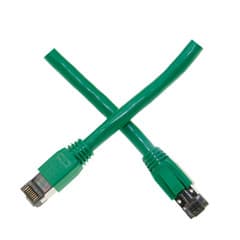 This 6-inch Category 8.1 cable, Class I channel, features a green PVC jacket, braided outer shield, with four individually mylar foil shielded 24 AWG pure copper pairs as defined in ISO/IEC 11801 and ratified in ANSI/TIA 568-C.2-1. Cat8 cabling was designed primarily for high-speed data centers where switches, servers, and other network hardware are located in close proximity. This newest copper communications cable offers greater flexibility both literally and in distances when compared to QSFP+ and Twinax DAC assemblies which typically cost significantly more and are often much more limited in scope. It has the reach to cover Top-of-Rack and End-of-Row or Middle-of-Row network topologies while delivering 10, 25, and 40 Gigabit data rates over BASE-T technology with RJ45 ends making it a drop-in replacement for Cat6a where rates beyond 10Gb will be needed today or in the future. Cat8 has stricter specifications for noise restriction and crosstalk than any of its predecessors. The individual conductors are 24 AWG (American wire gauge) stranded pure copper. Cat8 patch cables are stranded to improve flexibility. Pure copper conductors provide the best signal possible. Each pair of conductors is shielded with an aluminum mylar foil to reduce, if not eliminate, crosstalk. These cables also have a braided shield, which protects from outside electromagnetic interference.Part No. 13X8-55100.5
This 6-inch Category 8.1 cable, Class I channel, features a green PVC jacket, braided outer shield, with four individually mylar foil shielded 24 AWG pure copper pairs as defined in ISO/IEC 11801 and ratified in ANSI/TIA 568-C.2-1. Cat8 cabling was designed primarily for high-speed data centers where switches, servers, and other network hardware are located in close proximity. This newest copper communications cable offers greater flexibility both literally and in distances when compared to QSFP+ and Twinax DAC assemblies which typically cost significantly more and are often much more limited in scope. It has the reach to cover Top-of-Rack and End-of-Row or Middle-of-Row network topologies while delivering 10, 25, and 40 Gigabit data rates over BASE-T technology with RJ45 ends making it a drop-in replacement for Cat6a where rates beyond 10Gb will be needed today or in the future. Cat8 has stricter specifications for noise restriction and crosstalk than any of its predecessors. The individual conductors are 24 AWG (American wire gauge) stranded pure copper. Cat8 patch cables are stranded to improve flexibility. Pure copper conductors provide the best signal possible. Each pair of conductors is shielded with an aluminum mylar foil to reduce, if not eliminate, crosstalk. These cables also have a braided shield, which protects from outside electromagnetic interference.Part No. 13X8-55100.5 -
 This 1-foot Category 8.1 cable, Class I channel, features a green PVC jacket, braided outer shield, with four individually mylar foil shielded 24 AWG pure copper pairs as defined in ISO/IEC 11801 and ratified in ANSI/TIA 568-C.2-1. Cat8 cabling was designed primarily for high-speed data centers where switches, servers, and other network hardware are located in close proximity. This newest copper communications cable offers greater flexibility both literally and in distances when compared to QSFP+ and Twinax DAC assemblies which typically cost significantly more and are often much more limited in scope. It has the reach to cover Top-of-Rack and End-of-Row or Middle-of-Row network topologies while delivering 10, 25, and 40 Gigabit data rates over BASE-T technology with RJ45 ends making it a drop-in replacement for Cat6a where rates beyond 10Gb will be needed today or in the future. Cat8 has stricter specifications for noise restriction and crosstalk than any of its predecessors. The individual conductors are 24 AWG (American wire gauge) stranded pure copper. Cat8 patch cables are stranded to improve flexibility. Pure copper conductors provide the best signal possible. Each pair of conductors is shielded with an aluminum mylar foil to reduce, if not eliminate, crosstalk. These cables also have a braided shield, which protects from outside electromagnetic interference.Part No. 13X8-55101
This 1-foot Category 8.1 cable, Class I channel, features a green PVC jacket, braided outer shield, with four individually mylar foil shielded 24 AWG pure copper pairs as defined in ISO/IEC 11801 and ratified in ANSI/TIA 568-C.2-1. Cat8 cabling was designed primarily for high-speed data centers where switches, servers, and other network hardware are located in close proximity. This newest copper communications cable offers greater flexibility both literally and in distances when compared to QSFP+ and Twinax DAC assemblies which typically cost significantly more and are often much more limited in scope. It has the reach to cover Top-of-Rack and End-of-Row or Middle-of-Row network topologies while delivering 10, 25, and 40 Gigabit data rates over BASE-T technology with RJ45 ends making it a drop-in replacement for Cat6a where rates beyond 10Gb will be needed today or in the future. Cat8 has stricter specifications for noise restriction and crosstalk than any of its predecessors. The individual conductors are 24 AWG (American wire gauge) stranded pure copper. Cat8 patch cables are stranded to improve flexibility. Pure copper conductors provide the best signal possible. Each pair of conductors is shielded with an aluminum mylar foil to reduce, if not eliminate, crosstalk. These cables also have a braided shield, which protects from outside electromagnetic interference.Part No. 13X8-55101 -
 This 5-foot Category 8.1 cable, Class I channel, features a green PVC jacket, braided outer shield, with four individually mylar foil shielded 24 AWG pure copper pairs as defined in ISO/IEC 11801 and ratified in ANSI/TIA 568-C.2-1. Cat8 cabling was designed primarily for high-speed data centers where switches, servers, and other network hardware are located in close proximity. This newest copper communications cable offers greater flexibility both literally and in distances when compared to QSFP+ and Twinax DAC assemblies which typically cost significantly more and are often much more limited in scope. It has the reach to cover Top-of-Rack and End-of-Row or Middle-of-Row network topologies while delivering 10, 25, and 40 Gigabit data rates over BASE-T technology with RJ45 ends making it a drop-in replacement for Cat6a where rates beyond 10Gb will be needed today or in the future. Cat8 has stricter specifications for noise restriction and crosstalk than any of its predecessors. The individual conductors are 24 AWG (American wire gauge) stranded pure copper. Cat8 patch cables are stranded to improve flexibility. Pure copper conductors provide the best signal possible. Each pair of conductors is shielded with an aluminum mylar foil to reduce, if not eliminate, crosstalk. These cables also have a braided shield, which protects from outside electromagnetic interference.Part No. 13X8-55105
This 5-foot Category 8.1 cable, Class I channel, features a green PVC jacket, braided outer shield, with four individually mylar foil shielded 24 AWG pure copper pairs as defined in ISO/IEC 11801 and ratified in ANSI/TIA 568-C.2-1. Cat8 cabling was designed primarily for high-speed data centers where switches, servers, and other network hardware are located in close proximity. This newest copper communications cable offers greater flexibility both literally and in distances when compared to QSFP+ and Twinax DAC assemblies which typically cost significantly more and are often much more limited in scope. It has the reach to cover Top-of-Rack and End-of-Row or Middle-of-Row network topologies while delivering 10, 25, and 40 Gigabit data rates over BASE-T technology with RJ45 ends making it a drop-in replacement for Cat6a where rates beyond 10Gb will be needed today or in the future. Cat8 has stricter specifications for noise restriction and crosstalk than any of its predecessors. The individual conductors are 24 AWG (American wire gauge) stranded pure copper. Cat8 patch cables are stranded to improve flexibility. Pure copper conductors provide the best signal possible. Each pair of conductors is shielded with an aluminum mylar foil to reduce, if not eliminate, crosstalk. These cables also have a braided shield, which protects from outside electromagnetic interference.Part No. 13X8-55105 -
 This 7-foot Category 8.1 cable, Class I channel, features a green PVC jacket, braided outer shield, with four individually mylar foil shielded 24 AWG pure copper pairs as defined in ISO/IEC 11801 and ratified in ANSI/TIA 568-C.2-1. Cat8 cabling was designed primarily for high-speed data centers where switches, servers, and other network hardware are located in close proximity. This newest copper communications cable offers greater flexibility both literally and in distances when compared to QSFP+ and Twinax DAC assemblies which typically cost significantly more and are often much more limited in scope. It has the reach to cover Top-of-Rack and End-of-Row or Middle-of-Row network topologies while delivering 10, 25, and 40 Gigabit data rates over BASE-T technology with RJ45 ends making it a drop-in replacement for Cat6a where rates beyond 10Gb will be needed today or in the future. Cat8 has stricter specifications for noise restriction and crosstalk than any of its predecessors. The individual conductors are 24 AWG (American wire gauge) stranded pure copper. Cat8 patch cables are stranded to improve flexibility. Pure copper conductors provide the best signal possible. Each pair of conductors is shielded with an aluminum mylar foil to reduce, if not eliminate, crosstalk. These cables also have a braided shield, which protects from outside electromagnetic interference.Part No. 13X8-55107
This 7-foot Category 8.1 cable, Class I channel, features a green PVC jacket, braided outer shield, with four individually mylar foil shielded 24 AWG pure copper pairs as defined in ISO/IEC 11801 and ratified in ANSI/TIA 568-C.2-1. Cat8 cabling was designed primarily for high-speed data centers where switches, servers, and other network hardware are located in close proximity. This newest copper communications cable offers greater flexibility both literally and in distances when compared to QSFP+ and Twinax DAC assemblies which typically cost significantly more and are often much more limited in scope. It has the reach to cover Top-of-Rack and End-of-Row or Middle-of-Row network topologies while delivering 10, 25, and 40 Gigabit data rates over BASE-T technology with RJ45 ends making it a drop-in replacement for Cat6a where rates beyond 10Gb will be needed today or in the future. Cat8 has stricter specifications for noise restriction and crosstalk than any of its predecessors. The individual conductors are 24 AWG (American wire gauge) stranded pure copper. Cat8 patch cables are stranded to improve flexibility. Pure copper conductors provide the best signal possible. Each pair of conductors is shielded with an aluminum mylar foil to reduce, if not eliminate, crosstalk. These cables also have a braided shield, which protects from outside electromagnetic interference.Part No. 13X8-55107 -
 This 10-foot Category 8.1 cable, Class I channel, features a green PVC jacket, braided outer shield, with four individually mylar foil shielded 24 AWG pure copper pairs as defined in ISO/IEC 11801 and ratified in ANSI/TIA 568-C.2-1. Cat8 cabling was designed primarily for high-speed data centers where switches, servers, and other network hardware are located in close proximity. This newest copper communications cable offers greater flexibility both literally and in distances when compared to QSFP+ and Twinax DAC assemblies which typically cost significantly more and are often much more limited in scope. It has the reach to cover Top-of-Rack and End-of-Row or Middle-of-Row network topologies while delivering 10, 25, and 40 Gigabit data rates over BASE-T technology with RJ45 ends making it a drop-in replacement for Cat6a where rates beyond 10Gb will be needed today or in the future. Cat8 has stricter specifications for noise restriction and crosstalk than any of its predecessors. The individual conductors are 24 AWG (American wire gauge) stranded pure copper. Cat8 patch cables are stranded to improve flexibility. Pure copper conductors provide the best signal possible. Each pair of conductors is shielded with an aluminum mylar foil to reduce, if not eliminate, crosstalk. These cables also have a braided shield, which protects from outside electromagnetic interference.Part No. 13X8-55110
This 10-foot Category 8.1 cable, Class I channel, features a green PVC jacket, braided outer shield, with four individually mylar foil shielded 24 AWG pure copper pairs as defined in ISO/IEC 11801 and ratified in ANSI/TIA 568-C.2-1. Cat8 cabling was designed primarily for high-speed data centers where switches, servers, and other network hardware are located in close proximity. This newest copper communications cable offers greater flexibility both literally and in distances when compared to QSFP+ and Twinax DAC assemblies which typically cost significantly more and are often much more limited in scope. It has the reach to cover Top-of-Rack and End-of-Row or Middle-of-Row network topologies while delivering 10, 25, and 40 Gigabit data rates over BASE-T technology with RJ45 ends making it a drop-in replacement for Cat6a where rates beyond 10Gb will be needed today or in the future. Cat8 has stricter specifications for noise restriction and crosstalk than any of its predecessors. The individual conductors are 24 AWG (American wire gauge) stranded pure copper. Cat8 patch cables are stranded to improve flexibility. Pure copper conductors provide the best signal possible. Each pair of conductors is shielded with an aluminum mylar foil to reduce, if not eliminate, crosstalk. These cables also have a braided shield, which protects from outside electromagnetic interference.Part No. 13X8-55110 -
 This 25-foot Category 8.1 cable, Class I channel, features a green PVC jacket, braided outer shield, with four individually mylar foil shielded 24 AWG pure copper pairs as defined in ISO/IEC 11801 and ratified in ANSI/TIA 568-C.2-1. Cat8 cabling was designed primarily for high-speed data centers where switches, servers, and other network hardware are located in close proximity. This newest copper communications cable offers greater flexibility both literally and in distances when compared to QSFP+ and Twinax DAC assemblies which typically cost significantly more and are often much more limited in scope. It has the reach to cover Top-of-Rack and End-of-Row or Middle-of-Row network topologies while delivering 10, 25, and 40 Gigabit data rates over BASE-T technology with RJ45 ends making it a drop-in replacement for Cat6a where rates beyond 10Gb will be needed today or in the future. Cat8 has stricter specifications for noise restriction and crosstalk than any of its predecessors. The individual conductors are 24 AWG (American wire gauge) stranded pure copper. Cat8 patch cables are stranded to improve flexibility. Pure copper conductors provide the best signal possible. Each pair of conductors is shielded with an aluminum mylar foil to reduce, if not eliminate, crosstalk. These cables also have a braided shield, which protects from outside electromagnetic interference.Part No. 13X8-55125
This 25-foot Category 8.1 cable, Class I channel, features a green PVC jacket, braided outer shield, with four individually mylar foil shielded 24 AWG pure copper pairs as defined in ISO/IEC 11801 and ratified in ANSI/TIA 568-C.2-1. Cat8 cabling was designed primarily for high-speed data centers where switches, servers, and other network hardware are located in close proximity. This newest copper communications cable offers greater flexibility both literally and in distances when compared to QSFP+ and Twinax DAC assemblies which typically cost significantly more and are often much more limited in scope. It has the reach to cover Top-of-Rack and End-of-Row or Middle-of-Row network topologies while delivering 10, 25, and 40 Gigabit data rates over BASE-T technology with RJ45 ends making it a drop-in replacement for Cat6a where rates beyond 10Gb will be needed today or in the future. Cat8 has stricter specifications for noise restriction and crosstalk than any of its predecessors. The individual conductors are 24 AWG (American wire gauge) stranded pure copper. Cat8 patch cables are stranded to improve flexibility. Pure copper conductors provide the best signal possible. Each pair of conductors is shielded with an aluminum mylar foil to reduce, if not eliminate, crosstalk. These cables also have a braided shield, which protects from outside electromagnetic interference.Part No. 13X8-55125 -
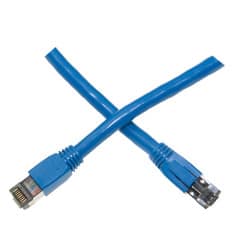 This 6-inch Category 8.1 cable, Class I channel, features a blue PVC jacket, braided outer shield, with four individually mylar foil shielded 24 AWG pure copper pairs as defined in ISO/IEC 11801 and ratified in ANSI/TIA 568-C.2-1. Cat8 cabling was designed primarily for high-speed data centers where switches, servers, and other network hardware are located in close proximity. This newest copper communications cable offers greater flexibility both literally and in distances when compared to QSFP+ and Twinax DAC assemblies which typically cost significantly more and are often much more limited in scope. It has the reach to cover Top-of-Rack and End-of-Row or Middle-of-Row network topologies while delivering 10, 25, and 40 Gigabit data rates over BASE-T technology with RJ45 ends making it a drop-in replacement for Cat6a where rates beyond 10Gb will be needed today or in the future. Cat8 has stricter specifications for noise restriction and crosstalk than any of its predecessors. The individual conductors are 24 AWG (American wire gauge) stranded pure copper. Cat8 patch cables are stranded to improve flexibility. Pure copper conductors provide the best signal possible. Each pair of conductors is shielded with an aluminum mylar foil to reduce, if not eliminate, crosstalk. These cables also have a braided shield, which protects from outside electromagnetic interference.Part No. 13X8-56100.5
This 6-inch Category 8.1 cable, Class I channel, features a blue PVC jacket, braided outer shield, with four individually mylar foil shielded 24 AWG pure copper pairs as defined in ISO/IEC 11801 and ratified in ANSI/TIA 568-C.2-1. Cat8 cabling was designed primarily for high-speed data centers where switches, servers, and other network hardware are located in close proximity. This newest copper communications cable offers greater flexibility both literally and in distances when compared to QSFP+ and Twinax DAC assemblies which typically cost significantly more and are often much more limited in scope. It has the reach to cover Top-of-Rack and End-of-Row or Middle-of-Row network topologies while delivering 10, 25, and 40 Gigabit data rates over BASE-T technology with RJ45 ends making it a drop-in replacement for Cat6a where rates beyond 10Gb will be needed today or in the future. Cat8 has stricter specifications for noise restriction and crosstalk than any of its predecessors. The individual conductors are 24 AWG (American wire gauge) stranded pure copper. Cat8 patch cables are stranded to improve flexibility. Pure copper conductors provide the best signal possible. Each pair of conductors is shielded with an aluminum mylar foil to reduce, if not eliminate, crosstalk. These cables also have a braided shield, which protects from outside electromagnetic interference.Part No. 13X8-56100.5 -
 This 3-foot Category 8.1 cable, Class I channel, features a blue PVC jacket, braided outer shield, with four individually mylar foil shielded 24 AWG pure copper pairs as defined in ISO/IEC 11801 and ratified in ANSI/TIA 568-C.2-1. Cat8 cabling was designed primarily for high-speed data centers where switches, servers, and other network hardware are located in close proximity. This newest copper communications cable offers greater flexibility both literally and in distances when compared to QSFP+ and Twinax DAC assemblies which typically cost significantly more and are often much more limited in scope. It has the reach to cover Top-of-Rack and End-of-Row or Middle-of-Row network topologies while delivering 10, 25, and 40 Gigabit data rates over BASE-T technology with RJ45 ends making it a drop-in replacement for Cat6a where rates beyond 10Gb will be needed today or in the future. Cat8 has stricter specifications for noise restriction and crosstalk than any of its predecessors. The individual conductors are 24 AWG (American wire gauge) stranded pure copper. Cat8 patch cables are stranded to improve flexibility. Pure copper conductors provide the best signal possible. Each pair of conductors is shielded with an aluminum mylar foil to reduce, if not eliminate, crosstalk. These cables also have a braided shield, which protects from outside electromagnetic interference.Part No. 13X8-56103
This 3-foot Category 8.1 cable, Class I channel, features a blue PVC jacket, braided outer shield, with four individually mylar foil shielded 24 AWG pure copper pairs as defined in ISO/IEC 11801 and ratified in ANSI/TIA 568-C.2-1. Cat8 cabling was designed primarily for high-speed data centers where switches, servers, and other network hardware are located in close proximity. This newest copper communications cable offers greater flexibility both literally and in distances when compared to QSFP+ and Twinax DAC assemblies which typically cost significantly more and are often much more limited in scope. It has the reach to cover Top-of-Rack and End-of-Row or Middle-of-Row network topologies while delivering 10, 25, and 40 Gigabit data rates over BASE-T technology with RJ45 ends making it a drop-in replacement for Cat6a where rates beyond 10Gb will be needed today or in the future. Cat8 has stricter specifications for noise restriction and crosstalk than any of its predecessors. The individual conductors are 24 AWG (American wire gauge) stranded pure copper. Cat8 patch cables are stranded to improve flexibility. Pure copper conductors provide the best signal possible. Each pair of conductors is shielded with an aluminum mylar foil to reduce, if not eliminate, crosstalk. These cables also have a braided shield, which protects from outside electromagnetic interference.Part No. 13X8-56103 -
 This 5-foot Category 8.1 cable, Class I channel, features a blue PVC jacket, braided outer shield, with four individually mylar foil shielded 24 AWG pure copper pairs as defined in ISO/IEC 11801 and ratified in ANSI/TIA 568-C.2-1. Cat8 cabling was designed primarily for high-speed data centers where switches, servers, and other network hardware are located in close proximity. This newest copper communications cable offers greater flexibility both literally and in distances when compared to QSFP+ and Twinax DAC assemblies which typically cost significantly more and are often much more limited in scope. It has the reach to cover Top-of-Rack and End-of-Row or Middle-of-Row network topologies while delivering 10, 25, and 40 Gigabit data rates over BASE-T technology with RJ45 ends making it a drop-in replacement for Cat6a where rates beyond 10Gb will be needed today or in the future. Cat8 has stricter specifications for noise restriction and crosstalk than any of its predecessors. The individual conductors are 24 AWG (American wire gauge) stranded pure copper. Cat8 patch cables are stranded to improve flexibility. Pure copper conductors provide the best signal possible. Each pair of conductors is shielded with an aluminum mylar foil to reduce, if not eliminate, crosstalk. These cables also have a braided shield, which protects from outside electromagnetic interference.Part No. 13X8-56105
This 5-foot Category 8.1 cable, Class I channel, features a blue PVC jacket, braided outer shield, with four individually mylar foil shielded 24 AWG pure copper pairs as defined in ISO/IEC 11801 and ratified in ANSI/TIA 568-C.2-1. Cat8 cabling was designed primarily for high-speed data centers where switches, servers, and other network hardware are located in close proximity. This newest copper communications cable offers greater flexibility both literally and in distances when compared to QSFP+ and Twinax DAC assemblies which typically cost significantly more and are often much more limited in scope. It has the reach to cover Top-of-Rack and End-of-Row or Middle-of-Row network topologies while delivering 10, 25, and 40 Gigabit data rates over BASE-T technology with RJ45 ends making it a drop-in replacement for Cat6a where rates beyond 10Gb will be needed today or in the future. Cat8 has stricter specifications for noise restriction and crosstalk than any of its predecessors. The individual conductors are 24 AWG (American wire gauge) stranded pure copper. Cat8 patch cables are stranded to improve flexibility. Pure copper conductors provide the best signal possible. Each pair of conductors is shielded with an aluminum mylar foil to reduce, if not eliminate, crosstalk. These cables also have a braided shield, which protects from outside electromagnetic interference.Part No. 13X8-56105 -
 This 7-foot Category 8.1 cable, Class I channel, features a blue PVC jacket, braided outer shield, with four individually mylar foil shielded 24 AWG pure copper pairs as defined in ISO/IEC 11801 and ratified in ANSI/TIA 568-C.2-1. Cat8 cabling was designed primarily for high-speed data centers where switches, servers, and other network hardware are located in close proximity. This newest copper communications cable offers greater flexibility both literally and in distances when compared to QSFP+ and Twinax DAC assemblies which typically cost significantly more and are often much more limited in scope. It has the reach to cover Top-of-Rack and End-of-Row or Middle-of-Row network topologies while delivering 10, 25, and 40 Gigabit data rates over BASE-T technology with RJ45 ends making it a drop-in replacement for Cat6a where rates beyond 10Gb will be needed today or in the future. Cat8 has stricter specifications for noise restriction and crosstalk than any of its predecessors. The individual conductors are 24 AWG (American wire gauge) stranded pure copper. Cat8 patch cables are stranded to improve flexibility. Pure copper conductors provide the best signal possible. Each pair of conductors is shielded with an aluminum mylar foil to reduce, if not eliminate, crosstalk. These cables also have a braided shield, which protects from outside electromagnetic interference.Part No. 13X8-56107
This 7-foot Category 8.1 cable, Class I channel, features a blue PVC jacket, braided outer shield, with four individually mylar foil shielded 24 AWG pure copper pairs as defined in ISO/IEC 11801 and ratified in ANSI/TIA 568-C.2-1. Cat8 cabling was designed primarily for high-speed data centers where switches, servers, and other network hardware are located in close proximity. This newest copper communications cable offers greater flexibility both literally and in distances when compared to QSFP+ and Twinax DAC assemblies which typically cost significantly more and are often much more limited in scope. It has the reach to cover Top-of-Rack and End-of-Row or Middle-of-Row network topologies while delivering 10, 25, and 40 Gigabit data rates over BASE-T technology with RJ45 ends making it a drop-in replacement for Cat6a where rates beyond 10Gb will be needed today or in the future. Cat8 has stricter specifications for noise restriction and crosstalk than any of its predecessors. The individual conductors are 24 AWG (American wire gauge) stranded pure copper. Cat8 patch cables are stranded to improve flexibility. Pure copper conductors provide the best signal possible. Each pair of conductors is shielded with an aluminum mylar foil to reduce, if not eliminate, crosstalk. These cables also have a braided shield, which protects from outside electromagnetic interference.Part No. 13X8-56107 -
 This 10-foot Category 8.1 cable, Class I channel, features a blue PVC jacket, braided outer shield, with four individually mylar foil shielded 24 AWG pure copper pairs as defined in ISO/IEC 11801 and ratified in ANSI/TIA 568-C.2-1. Cat8 cabling was designed primarily for high-speed data centers where switches, servers, and other network hardware are located in close proximity. This newest copper communications cable offers greater flexibility both literally and in distances when compared to QSFP+ and Twinax DAC assemblies which typically cost significantly more and are often much more limited in scope. It has the reach to cover Top-of-Rack and End-of-Row or Middle-of-Row network topologies while delivering 10, 25, and 40 Gigabit data rates over BASE-T technology with RJ45 ends making it a drop-in replacement for Cat6a where rates beyond 10Gb will be needed today or in the future. Cat8 has stricter specifications for noise restriction and crosstalk than any of its predecessors. The individual conductors are 24 AWG (American wire gauge) stranded pure copper. Cat8 patch cables are stranded to improve flexibility. Pure copper conductors provide the best signal possible. Each pair of conductors is shielded with an aluminum mylar foil to reduce, if not eliminate, crosstalk. These cables also have a braided shield, which protects from outside electromagnetic interference.Part No. 13X8-56110
This 10-foot Category 8.1 cable, Class I channel, features a blue PVC jacket, braided outer shield, with four individually mylar foil shielded 24 AWG pure copper pairs as defined in ISO/IEC 11801 and ratified in ANSI/TIA 568-C.2-1. Cat8 cabling was designed primarily for high-speed data centers where switches, servers, and other network hardware are located in close proximity. This newest copper communications cable offers greater flexibility both literally and in distances when compared to QSFP+ and Twinax DAC assemblies which typically cost significantly more and are often much more limited in scope. It has the reach to cover Top-of-Rack and End-of-Row or Middle-of-Row network topologies while delivering 10, 25, and 40 Gigabit data rates over BASE-T technology with RJ45 ends making it a drop-in replacement for Cat6a where rates beyond 10Gb will be needed today or in the future. Cat8 has stricter specifications for noise restriction and crosstalk than any of its predecessors. The individual conductors are 24 AWG (American wire gauge) stranded pure copper. Cat8 patch cables are stranded to improve flexibility. Pure copper conductors provide the best signal possible. Each pair of conductors is shielded with an aluminum mylar foil to reduce, if not eliminate, crosstalk. These cables also have a braided shield, which protects from outside electromagnetic interference.Part No. 13X8-56110 -
 This 15-foot Category 8.1 cable, Class I channel, features a blue PVC jacket, braided outer shield, with four individually mylar foil shielded 24 AWG pure copper pairs as defined in ISO/IEC 11801 and ratified in ANSI/TIA 568-C.2-1. Cat8 cabling was designed primarily for high-speed data centers where switches, servers, and other network hardware are located in close proximity. This newest copper communications cable offers greater flexibility both literally and in distances when compared to QSFP+ and Twinax DAC assemblies which typically cost significantly more and are often much more limited in scope. It has the reach to cover Top-of-Rack and End-of-Row or Middle-of-Row network topologies while delivering 10, 25, and 40 Gigabit data rates over BASE-T technology with RJ45 ends making it a drop-in replacement for Cat6a where rates beyond 10Gb will be needed today or in the future. Cat8 has stricter specifications for noise restriction and crosstalk than any of its predecessors. The individual conductors are 24 AWG (American wire gauge) stranded pure copper. Cat8 patch cables are stranded to improve flexibility. Pure copper conductors provide the best signal possible. Each pair of conductors is shielded with an aluminum mylar foil to reduce, if not eliminate, crosstalk. These cables also have a braided shield, which protects from outside electromagnetic interference.Part No. 13X8-56115
This 15-foot Category 8.1 cable, Class I channel, features a blue PVC jacket, braided outer shield, with four individually mylar foil shielded 24 AWG pure copper pairs as defined in ISO/IEC 11801 and ratified in ANSI/TIA 568-C.2-1. Cat8 cabling was designed primarily for high-speed data centers where switches, servers, and other network hardware are located in close proximity. This newest copper communications cable offers greater flexibility both literally and in distances when compared to QSFP+ and Twinax DAC assemblies which typically cost significantly more and are often much more limited in scope. It has the reach to cover Top-of-Rack and End-of-Row or Middle-of-Row network topologies while delivering 10, 25, and 40 Gigabit data rates over BASE-T technology with RJ45 ends making it a drop-in replacement for Cat6a where rates beyond 10Gb will be needed today or in the future. Cat8 has stricter specifications for noise restriction and crosstalk than any of its predecessors. The individual conductors are 24 AWG (American wire gauge) stranded pure copper. Cat8 patch cables are stranded to improve flexibility. Pure copper conductors provide the best signal possible. Each pair of conductors is shielded with an aluminum mylar foil to reduce, if not eliminate, crosstalk. These cables also have a braided shield, which protects from outside electromagnetic interference.Part No. 13X8-56115 -
 This 50-foot Category 8.1 cable, Class I channel, features a blue PVC jacket, braided outer shield, with four individually mylar foil shielded 24 AWG pure copper pairs as defined in ISO/IEC 11801 and ratified in ANSI/TIA 568-C.2-1. Cat8 cabling was designed primarily for high-speed data centers where switches, servers, and other network hardware are located in close proximity. This newest copper communications cable offers greater flexibility both literally and in distances when compared to QSFP+ and Twinax DAC assemblies which typically cost significantly more and are often much more limited in scope. It has the reach to cover Top-of-Rack and End-of-Row or Middle-of-Row network topologies while delivering 10, 25, and 40 Gigabit data rates over BASE-T technology with RJ45 ends making it a drop-in replacement for Cat6a where rates beyond 10Gb will be needed today or in the future. Cat8 has stricter specifications for noise restriction and crosstalk than any of its predecessors. The individual conductors are 24 AWG (American wire gauge) stranded pure copper. Cat8 patch cables are stranded to improve flexibility. Pure copper conductors provide the best signal possible. Each pair of conductors is shielded with an aluminum mylar foil to reduce, if not eliminate, crosstalk. These cables also have a braided shield, which protects from outside electromagnetic interference.Part No. 13X8-56150
This 50-foot Category 8.1 cable, Class I channel, features a blue PVC jacket, braided outer shield, with four individually mylar foil shielded 24 AWG pure copper pairs as defined in ISO/IEC 11801 and ratified in ANSI/TIA 568-C.2-1. Cat8 cabling was designed primarily for high-speed data centers where switches, servers, and other network hardware are located in close proximity. This newest copper communications cable offers greater flexibility both literally and in distances when compared to QSFP+ and Twinax DAC assemblies which typically cost significantly more and are often much more limited in scope. It has the reach to cover Top-of-Rack and End-of-Row or Middle-of-Row network topologies while delivering 10, 25, and 40 Gigabit data rates over BASE-T technology with RJ45 ends making it a drop-in replacement for Cat6a where rates beyond 10Gb will be needed today or in the future. Cat8 has stricter specifications for noise restriction and crosstalk than any of its predecessors. The individual conductors are 24 AWG (American wire gauge) stranded pure copper. Cat8 patch cables are stranded to improve flexibility. Pure copper conductors provide the best signal possible. Each pair of conductors is shielded with an aluminum mylar foil to reduce, if not eliminate, crosstalk. These cables also have a braided shield, which protects from outside electromagnetic interference.Part No. 13X8-56150 -
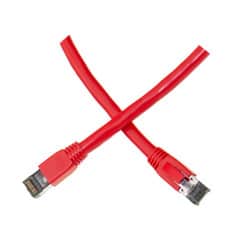 This 6-inch Category 8.1 cable, Class I channel, features a red PVC jacket, braided outer shield, with four individually mylar foil shielded 24 AWG pure copper pairs as defined in ISO/IEC 11801 and ratified in ANSI/TIA 568-C.2-1. Cat8 cabling was designed primarily for high-speed data centers where switches, servers, and other network hardware are located in close proximity. This newest copper communications cable offers greater flexibility both literally and in distances when compared to QSFP+ and Twinax DAC assemblies which typically cost significantly more and are often much more limited in scope. It has the reach to cover Top-of-Rack and End-of-Row or Middle-of-Row network topologies while delivering 10, 25, and 40 Gigabit data rates over BASE-T technology with RJ45 ends making it a drop-in replacement for Cat6a where rates beyond 10Gb will be needed today or in the future. Cat8 has stricter specifications for noise restriction and crosstalk than any of its predecessors. The individual conductors are 24 AWG (American wire gauge) stranded pure copper. Cat8 patch cables are stranded to improve flexibility. Pure copper conductors provide the best signal possible. Each pair of conductors is shielded with an aluminum mylar foil to reduce, if not eliminate, crosstalk. These cables also have a braided shield, which protects from outside electromagnetic interference.Part No. 13X8-57100.5
This 6-inch Category 8.1 cable, Class I channel, features a red PVC jacket, braided outer shield, with four individually mylar foil shielded 24 AWG pure copper pairs as defined in ISO/IEC 11801 and ratified in ANSI/TIA 568-C.2-1. Cat8 cabling was designed primarily for high-speed data centers where switches, servers, and other network hardware are located in close proximity. This newest copper communications cable offers greater flexibility both literally and in distances when compared to QSFP+ and Twinax DAC assemblies which typically cost significantly more and are often much more limited in scope. It has the reach to cover Top-of-Rack and End-of-Row or Middle-of-Row network topologies while delivering 10, 25, and 40 Gigabit data rates over BASE-T technology with RJ45 ends making it a drop-in replacement for Cat6a where rates beyond 10Gb will be needed today or in the future. Cat8 has stricter specifications for noise restriction and crosstalk than any of its predecessors. The individual conductors are 24 AWG (American wire gauge) stranded pure copper. Cat8 patch cables are stranded to improve flexibility. Pure copper conductors provide the best signal possible. Each pair of conductors is shielded with an aluminum mylar foil to reduce, if not eliminate, crosstalk. These cables also have a braided shield, which protects from outside electromagnetic interference.Part No. 13X8-57100.5 -
 This 1-foot Category 8.1 cable, Class I channel, features a red PVC jacket, braided outer shield, with four individually mylar foil shielded 24 AWG pure copper pairs as defined in ISO/IEC 11801 and ratified in ANSI/TIA 568-C.2-1. Cat8 cabling was designed primarily for high-speed data centers where switches, servers, and other network hardware are located in close proximity. This newest copper communications cable offers greater flexibility both literally and in distances when compared to QSFP+ and Twinax DAC assemblies which typically cost significantly more and are often much more limited in scope. It has the reach to cover Top-of-Rack and End-of-Row or Middle-of-Row network topologies while delivering 10, 25, and 40 Gigabit data rates over BASE-T technology with RJ45 ends making it a drop-in replacement for Cat6a where rates beyond 10Gb will be needed today or in the future. Cat8 has stricter specifications for noise restriction and crosstalk than any of its predecessors. The individual conductors are 24 AWG (American wire gauge) stranded pure copper. Cat8 patch cables are stranded to improve flexibility. Pure copper conductors provide the best signal possible. Each pair of conductors is shielded with an aluminum mylar foil to reduce, if not eliminate, crosstalk. These cables also have a braided shield, which protects from outside electromagnetic interference.Part No. 13X8-57101
This 1-foot Category 8.1 cable, Class I channel, features a red PVC jacket, braided outer shield, with four individually mylar foil shielded 24 AWG pure copper pairs as defined in ISO/IEC 11801 and ratified in ANSI/TIA 568-C.2-1. Cat8 cabling was designed primarily for high-speed data centers where switches, servers, and other network hardware are located in close proximity. This newest copper communications cable offers greater flexibility both literally and in distances when compared to QSFP+ and Twinax DAC assemblies which typically cost significantly more and are often much more limited in scope. It has the reach to cover Top-of-Rack and End-of-Row or Middle-of-Row network topologies while delivering 10, 25, and 40 Gigabit data rates over BASE-T technology with RJ45 ends making it a drop-in replacement for Cat6a where rates beyond 10Gb will be needed today or in the future. Cat8 has stricter specifications for noise restriction and crosstalk than any of its predecessors. The individual conductors are 24 AWG (American wire gauge) stranded pure copper. Cat8 patch cables are stranded to improve flexibility. Pure copper conductors provide the best signal possible. Each pair of conductors is shielded with an aluminum mylar foil to reduce, if not eliminate, crosstalk. These cables also have a braided shield, which protects from outside electromagnetic interference.Part No. 13X8-57101 -
 This 2-foot Category 8.1 cable, Class I channel, features a red PVC jacket, braided outer shield, with four individually mylar foil shielded 24 AWG pure copper pairs as defined in ISO/IEC 11801 and ratified in ANSI/TIA 568-C.2-1. Cat8 cabling was designed primarily for high-speed data centers where switches, servers, and other network hardware are located in close proximity. This newest copper communications cable offers greater flexibility both literally and in distances when compared to QSFP+ and Twinax DAC assemblies which typically cost significantly more and are often much more limited in scope. It has the reach to cover Top-of-Rack and End-of-Row or Middle-of-Row network topologies while delivering 10, 25, and 40 Gigabit data rates over BASE-T technology with RJ45 ends making it a drop-in replacement for Cat6a where rates beyond 10Gb will be needed today or in the future. Cat8 has stricter specifications for noise restriction and crosstalk than any of its predecessors. The individual conductors are 24 AWG (American wire gauge) stranded pure copper. Cat8 patch cables are stranded to improve flexibility. Pure copper conductors provide the best signal possible. Each pair of conductors is shielded with an aluminum mylar foil to reduce, if not eliminate, crosstalk. These cables also have a braided shield, which protects from outside electromagnetic interference.Part No. 13X8-57102
This 2-foot Category 8.1 cable, Class I channel, features a red PVC jacket, braided outer shield, with four individually mylar foil shielded 24 AWG pure copper pairs as defined in ISO/IEC 11801 and ratified in ANSI/TIA 568-C.2-1. Cat8 cabling was designed primarily for high-speed data centers where switches, servers, and other network hardware are located in close proximity. This newest copper communications cable offers greater flexibility both literally and in distances when compared to QSFP+ and Twinax DAC assemblies which typically cost significantly more and are often much more limited in scope. It has the reach to cover Top-of-Rack and End-of-Row or Middle-of-Row network topologies while delivering 10, 25, and 40 Gigabit data rates over BASE-T technology with RJ45 ends making it a drop-in replacement for Cat6a where rates beyond 10Gb will be needed today or in the future. Cat8 has stricter specifications for noise restriction and crosstalk than any of its predecessors. The individual conductors are 24 AWG (American wire gauge) stranded pure copper. Cat8 patch cables are stranded to improve flexibility. Pure copper conductors provide the best signal possible. Each pair of conductors is shielded with an aluminum mylar foil to reduce, if not eliminate, crosstalk. These cables also have a braided shield, which protects from outside electromagnetic interference.Part No. 13X8-57102 -
 This 5-foot Category 8.1 cable, Class I channel, features a red PVC jacket, braided outer shield, with four individually mylar foil shielded 24 AWG pure copper pairs as defined in ISO/IEC 11801 and ratified in ANSI/TIA 568-C.2-1. Cat8 cabling was designed primarily for high-speed data centers where switches, servers, and other network hardware are located in close proximity. This newest copper communications cable offers greater flexibility both literally and in distances when compared to QSFP+ and Twinax DAC assemblies which typically cost significantly more and are often much more limited in scope. It has the reach to cover Top-of-Rack and End-of-Row or Middle-of-Row network topologies while delivering 10, 25, and 40 Gigabit data rates over BASE-T technology with RJ45 ends making it a drop-in replacement for Cat6a where rates beyond 10Gb will be needed today or in the future. Cat8 has stricter specifications for noise restriction and crosstalk than any of its predecessors. The individual conductors are 24 AWG (American wire gauge) stranded pure copper. Cat8 patch cables are stranded to improve flexibility. Pure copper conductors provide the best signal possible. Each pair of conductors is shielded with an aluminum mylar foil to reduce, if not eliminate, crosstalk. These cables also have a braided shield, which protects from outside electromagnetic interference.Part No. 13X8-57105
This 5-foot Category 8.1 cable, Class I channel, features a red PVC jacket, braided outer shield, with four individually mylar foil shielded 24 AWG pure copper pairs as defined in ISO/IEC 11801 and ratified in ANSI/TIA 568-C.2-1. Cat8 cabling was designed primarily for high-speed data centers where switches, servers, and other network hardware are located in close proximity. This newest copper communications cable offers greater flexibility both literally and in distances when compared to QSFP+ and Twinax DAC assemblies which typically cost significantly more and are often much more limited in scope. It has the reach to cover Top-of-Rack and End-of-Row or Middle-of-Row network topologies while delivering 10, 25, and 40 Gigabit data rates over BASE-T technology with RJ45 ends making it a drop-in replacement for Cat6a where rates beyond 10Gb will be needed today or in the future. Cat8 has stricter specifications for noise restriction and crosstalk than any of its predecessors. The individual conductors are 24 AWG (American wire gauge) stranded pure copper. Cat8 patch cables are stranded to improve flexibility. Pure copper conductors provide the best signal possible. Each pair of conductors is shielded with an aluminum mylar foil to reduce, if not eliminate, crosstalk. These cables also have a braided shield, which protects from outside electromagnetic interference.Part No. 13X8-57105 -
 This 7-foot Category 8.1 cable, Class I channel, features a red PVC jacket, braided outer shield, with four individually mylar foil shielded 24 AWG pure copper pairs as defined in ISO/IEC 11801 and ratified in ANSI/TIA 568-C.2-1. Cat8 cabling was designed primarily for high-speed data centers where switches, servers, and other network hardware are located in close proximity. This newest copper communications cable offers greater flexibility both literally and in distances when compared to QSFP+ and Twinax DAC assemblies which typically cost significantly more and are often much more limited in scope. It has the reach to cover Top-of-Rack and End-of-Row or Middle-of-Row network topologies while delivering 10, 25, and 40 Gigabit data rates over BASE-T technology with RJ45 ends making it a drop-in replacement for Cat6a where rates beyond 10Gb will be needed today or in the future. Cat8 has stricter specifications for noise restriction and crosstalk than any of its predecessors. The individual conductors are 24 AWG (American wire gauge) stranded pure copper. Cat8 patch cables are stranded to improve flexibility. Pure copper conductors provide the best signal possible. Each pair of conductors is shielded with an aluminum mylar foil to reduce, if not eliminate, crosstalk. These cables also have a braided shield, which protects from outside electromagnetic interference.Part No. 13X8-57107
This 7-foot Category 8.1 cable, Class I channel, features a red PVC jacket, braided outer shield, with four individually mylar foil shielded 24 AWG pure copper pairs as defined in ISO/IEC 11801 and ratified in ANSI/TIA 568-C.2-1. Cat8 cabling was designed primarily for high-speed data centers where switches, servers, and other network hardware are located in close proximity. This newest copper communications cable offers greater flexibility both literally and in distances when compared to QSFP+ and Twinax DAC assemblies which typically cost significantly more and are often much more limited in scope. It has the reach to cover Top-of-Rack and End-of-Row or Middle-of-Row network topologies while delivering 10, 25, and 40 Gigabit data rates over BASE-T technology with RJ45 ends making it a drop-in replacement for Cat6a where rates beyond 10Gb will be needed today or in the future. Cat8 has stricter specifications for noise restriction and crosstalk than any of its predecessors. The individual conductors are 24 AWG (American wire gauge) stranded pure copper. Cat8 patch cables are stranded to improve flexibility. Pure copper conductors provide the best signal possible. Each pair of conductors is shielded with an aluminum mylar foil to reduce, if not eliminate, crosstalk. These cables also have a braided shield, which protects from outside electromagnetic interference.Part No. 13X8-57107 -
 This 10-foot Category 8.1 cable, Class I channel, features a red PVC jacket, braided outer shield, with four individually mylar foil shielded 24 AWG pure copper pairs as defined in ISO/IEC 11801 and ratified in ANSI/TIA 568-C.2-1. Cat8 cabling was designed primarily for high-speed data centers where switches, servers, and other network hardware are located in close proximity. This newest copper communications cable offers greater flexibility both literally and in distances when compared to QSFP+ and Twinax DAC assemblies which typically cost significantly more and are often much more limited in scope. It has the reach to cover Top-of-Rack and End-of-Row or Middle-of-Row network topologies while delivering 10, 25, and 40 Gigabit data rates over BASE-T technology with RJ45 ends making it a drop-in replacement for Cat6a where rates beyond 10Gb will be needed today or in the future. Cat8 has stricter specifications for noise restriction and crosstalk than any of its predecessors. The individual conductors are 24 AWG (American wire gauge) stranded pure copper. Cat8 patch cables are stranded to improve flexibility. Pure copper conductors provide the best signal possible. Each pair of conductors is shielded with an aluminum mylar foil to reduce, if not eliminate, crosstalk. These cables also have a braided shield, which protects from outside electromagnetic interference.Part No. 13X8-57110
This 10-foot Category 8.1 cable, Class I channel, features a red PVC jacket, braided outer shield, with four individually mylar foil shielded 24 AWG pure copper pairs as defined in ISO/IEC 11801 and ratified in ANSI/TIA 568-C.2-1. Cat8 cabling was designed primarily for high-speed data centers where switches, servers, and other network hardware are located in close proximity. This newest copper communications cable offers greater flexibility both literally and in distances when compared to QSFP+ and Twinax DAC assemblies which typically cost significantly more and are often much more limited in scope. It has the reach to cover Top-of-Rack and End-of-Row or Middle-of-Row network topologies while delivering 10, 25, and 40 Gigabit data rates over BASE-T technology with RJ45 ends making it a drop-in replacement for Cat6a where rates beyond 10Gb will be needed today or in the future. Cat8 has stricter specifications for noise restriction and crosstalk than any of its predecessors. The individual conductors are 24 AWG (American wire gauge) stranded pure copper. Cat8 patch cables are stranded to improve flexibility. Pure copper conductors provide the best signal possible. Each pair of conductors is shielded with an aluminum mylar foil to reduce, if not eliminate, crosstalk. These cables also have a braided shield, which protects from outside electromagnetic interference.Part No. 13X8-57110 -
 This 15-foot Category 8.1 cable, Class I channel, features a red PVC jacket, braided outer shield, with four individually mylar foil shielded 24 AWG pure copper pairs as defined in ISO/IEC 11801 and ratified in ANSI/TIA 568-C.2-1. Cat8 cabling was designed primarily for high-speed data centers where switches, servers, and other network hardware are located in close proximity. This newest copper communications cable offers greater flexibility both literally and in distances when compared to QSFP+ and Twinax DAC assemblies which typically cost significantly more and are often much more limited in scope. It has the reach to cover Top-of-Rack and End-of-Row or Middle-of-Row network topologies while delivering 10, 25, and 40 Gigabit data rates over BASE-T technology with RJ45 ends making it a drop-in replacement for Cat6a where rates beyond 10Gb will be needed today or in the future. Cat8 has stricter specifications for noise restriction and crosstalk than any of its predecessors. The individual conductors are 24 AWG (American wire gauge) stranded pure copper. Cat8 patch cables are stranded to improve flexibility. Pure copper conductors provide the best signal possible. Each pair of conductors is shielded with an aluminum mylar foil to reduce, if not eliminate, crosstalk. These cables also have a braided shield, which protects from outside electromagnetic interference.Part No. 13X8-57115
This 15-foot Category 8.1 cable, Class I channel, features a red PVC jacket, braided outer shield, with four individually mylar foil shielded 24 AWG pure copper pairs as defined in ISO/IEC 11801 and ratified in ANSI/TIA 568-C.2-1. Cat8 cabling was designed primarily for high-speed data centers where switches, servers, and other network hardware are located in close proximity. This newest copper communications cable offers greater flexibility both literally and in distances when compared to QSFP+ and Twinax DAC assemblies which typically cost significantly more and are often much more limited in scope. It has the reach to cover Top-of-Rack and End-of-Row or Middle-of-Row network topologies while delivering 10, 25, and 40 Gigabit data rates over BASE-T technology with RJ45 ends making it a drop-in replacement for Cat6a where rates beyond 10Gb will be needed today or in the future. Cat8 has stricter specifications for noise restriction and crosstalk than any of its predecessors. The individual conductors are 24 AWG (American wire gauge) stranded pure copper. Cat8 patch cables are stranded to improve flexibility. Pure copper conductors provide the best signal possible. Each pair of conductors is shielded with an aluminum mylar foil to reduce, if not eliminate, crosstalk. These cables also have a braided shield, which protects from outside electromagnetic interference.Part No. 13X8-57115 -
 This 25-foot Category 8.1 cable, Class I channel, features a red PVC jacket, braided outer shield, with four individually mylar foil shielded 24 AWG pure copper pairs as defined in ISO/IEC 11801 and ratified in ANSI/TIA 568-C.2-1. Cat8 cabling was designed primarily for high-speed data centers where switches, servers, and other network hardware are located in close proximity. This newest copper communications cable offers greater flexibility both literally and in distances when compared to QSFP+ and Twinax DAC assemblies which typically cost significantly more and are often much more limited in scope. It has the reach to cover Top-of-Rack and End-of-Row or Middle-of-Row network topologies while delivering 10, 25, and 40 Gigabit data rates over BASE-T technology with RJ45 ends making it a drop-in replacement for Cat6a where rates beyond 10Gb will be needed today or in the future. Cat8 has stricter specifications for noise restriction and crosstalk than any of its predecessors. The individual conductors are 24 AWG (American wire gauge) stranded pure copper. Cat8 patch cables are stranded to improve flexibility. Pure copper conductors provide the best signal possible. Each pair of conductors is shielded with an aluminum mylar foil to reduce, if not eliminate, crosstalk. These cables also have a braided shield, which protects from outside electromagnetic interference.Part No. 13X8-57125
This 25-foot Category 8.1 cable, Class I channel, features a red PVC jacket, braided outer shield, with four individually mylar foil shielded 24 AWG pure copper pairs as defined in ISO/IEC 11801 and ratified in ANSI/TIA 568-C.2-1. Cat8 cabling was designed primarily for high-speed data centers where switches, servers, and other network hardware are located in close proximity. This newest copper communications cable offers greater flexibility both literally and in distances when compared to QSFP+ and Twinax DAC assemblies which typically cost significantly more and are often much more limited in scope. It has the reach to cover Top-of-Rack and End-of-Row or Middle-of-Row network topologies while delivering 10, 25, and 40 Gigabit data rates over BASE-T technology with RJ45 ends making it a drop-in replacement for Cat6a where rates beyond 10Gb will be needed today or in the future. Cat8 has stricter specifications for noise restriction and crosstalk than any of its predecessors. The individual conductors are 24 AWG (American wire gauge) stranded pure copper. Cat8 patch cables are stranded to improve flexibility. Pure copper conductors provide the best signal possible. Each pair of conductors is shielded with an aluminum mylar foil to reduce, if not eliminate, crosstalk. These cables also have a braided shield, which protects from outside electromagnetic interference.Part No. 13X8-57125 -
 This 35-foot Category 8.1 cable, Class I channel, features a red PVC jacket, braided outer shield, with four individually mylar foil shielded 24 AWG pure copper pairs as defined in ISO/IEC 11801 and ratified in ANSI/TIA 568-C.2-1. Cat8 cabling was designed primarily for high-speed data centers where switches, servers, and other network hardware are located in close proximity. This newest copper communications cable offers greater flexibility both literally and in distances when compared to QSFP+ and Twinax DAC assemblies which typically cost significantly more and are often much more limited in scope. It has the reach to cover Top-of-Rack and End-of-Row or Middle-of-Row network topologies while delivering 10, 25, and 40 Gigabit data rates over BASE-T technology with RJ45 ends making it a drop-in replacement for Cat6a where rates beyond 10Gb will be needed today or in the future. Cat8 has stricter specifications for noise restriction and crosstalk than any of its predecessors. The individual conductors are 24 AWG (American wire gauge) stranded pure copper. Cat8 patch cables are stranded to improve flexibility. Pure copper conductors provide the best signal possible. Each pair of conductors is shielded with an aluminum mylar foil to reduce, if not eliminate, crosstalk. These cables also have a braided shield, which protects from outside electromagnetic interference.Part No. 13X8-57135
This 35-foot Category 8.1 cable, Class I channel, features a red PVC jacket, braided outer shield, with four individually mylar foil shielded 24 AWG pure copper pairs as defined in ISO/IEC 11801 and ratified in ANSI/TIA 568-C.2-1. Cat8 cabling was designed primarily for high-speed data centers where switches, servers, and other network hardware are located in close proximity. This newest copper communications cable offers greater flexibility both literally and in distances when compared to QSFP+ and Twinax DAC assemblies which typically cost significantly more and are often much more limited in scope. It has the reach to cover Top-of-Rack and End-of-Row or Middle-of-Row network topologies while delivering 10, 25, and 40 Gigabit data rates over BASE-T technology with RJ45 ends making it a drop-in replacement for Cat6a where rates beyond 10Gb will be needed today or in the future. Cat8 has stricter specifications for noise restriction and crosstalk than any of its predecessors. The individual conductors are 24 AWG (American wire gauge) stranded pure copper. Cat8 patch cables are stranded to improve flexibility. Pure copper conductors provide the best signal possible. Each pair of conductors is shielded with an aluminum mylar foil to reduce, if not eliminate, crosstalk. These cables also have a braided shield, which protects from outside electromagnetic interference.Part No. 13X8-57135 -
 This 50-foot Category 8.1 cable, Class I channel, features a red PVC jacket, braided outer shield, with four individually mylar foil shielded 24 AWG pure copper pairs as defined in ISO/IEC 11801 and ratified in ANSI/TIA 568-C.2-1. Cat8 cabling was designed primarily for high-speed data centers where switches, servers, and other network hardware are located in close proximity. This newest copper communications cable offers greater flexibility both literally and in distances when compared to QSFP+ and Twinax DAC assemblies which typically cost significantly more and are often much more limited in scope. It has the reach to cover Top-of-Rack and End-of-Row or Middle-of-Row network topologies while delivering 10, 25, and 40 Gigabit data rates over BASE-T technology with RJ45 ends making it a drop-in replacement for Cat6a where rates beyond 10Gb will be needed today or in the future. Cat8 has stricter specifications for noise restriction and crosstalk than any of its predecessors. The individual conductors are 24 AWG (American wire gauge) stranded pure copper. Cat8 patch cables are stranded to improve flexibility. Pure copper conductors provide the best signal possible. Each pair of conductors is shielded with an aluminum mylar foil to reduce, if not eliminate, crosstalk. These cables also have a braided shield, which protects from outside electromagnetic interference.Part No. 13X8-57150
This 50-foot Category 8.1 cable, Class I channel, features a red PVC jacket, braided outer shield, with four individually mylar foil shielded 24 AWG pure copper pairs as defined in ISO/IEC 11801 and ratified in ANSI/TIA 568-C.2-1. Cat8 cabling was designed primarily for high-speed data centers where switches, servers, and other network hardware are located in close proximity. This newest copper communications cable offers greater flexibility both literally and in distances when compared to QSFP+ and Twinax DAC assemblies which typically cost significantly more and are often much more limited in scope. It has the reach to cover Top-of-Rack and End-of-Row or Middle-of-Row network topologies while delivering 10, 25, and 40 Gigabit data rates over BASE-T technology with RJ45 ends making it a drop-in replacement for Cat6a where rates beyond 10Gb will be needed today or in the future. Cat8 has stricter specifications for noise restriction and crosstalk than any of its predecessors. The individual conductors are 24 AWG (American wire gauge) stranded pure copper. Cat8 patch cables are stranded to improve flexibility. Pure copper conductors provide the best signal possible. Each pair of conductors is shielded with an aluminum mylar foil to reduce, if not eliminate, crosstalk. These cables also have a braided shield, which protects from outside electromagnetic interference.Part No. 13X8-57150 -
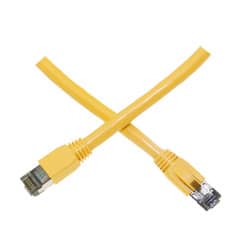 This 6-inch Category 8.1 cable, Class I channel, features a yellow PVC jacket, braided outer shield, with four individually mylar foil shielded 24 AWG pure copper pairs as defined in ISO/IEC 11801 and ratified in ANSI/TIA 568-C.2-1. Cat8 cabling was designed primarily for high-speed data centers where switches, servers, and other network hardware are located in close proximity. This newest copper communications cable offers greater flexibility both literally and in distances when compared to QSFP+ and Twinax DAC assemblies which typically cost significantly more and are often much more limited in scope. It has the reach to cover Top-of-Rack and End-of-Row or Middle-of-Row network topologies while delivering 10, 25, and 40 Gigabit data rates over BASE-T technology with RJ45 ends making it a drop-in replacement for Cat6a where rates beyond 10Gb will be needed today or in the future. Cat8 has stricter specifications for noise restriction and crosstalk than any of its predecessors. The individual conductors are 24 AWG (American wire gauge) stranded pure copper. Cat8 patch cables are stranded to improve flexibility. Pure copper conductors provide the best signal possible. Each pair of conductors is shielded with an aluminum mylar foil to reduce, if not eliminate, crosstalk. These cables also have a braided shield, which protects from outside electromagnetic interference.Part No. 13X8-58100.5
This 6-inch Category 8.1 cable, Class I channel, features a yellow PVC jacket, braided outer shield, with four individually mylar foil shielded 24 AWG pure copper pairs as defined in ISO/IEC 11801 and ratified in ANSI/TIA 568-C.2-1. Cat8 cabling was designed primarily for high-speed data centers where switches, servers, and other network hardware are located in close proximity. This newest copper communications cable offers greater flexibility both literally and in distances when compared to QSFP+ and Twinax DAC assemblies which typically cost significantly more and are often much more limited in scope. It has the reach to cover Top-of-Rack and End-of-Row or Middle-of-Row network topologies while delivering 10, 25, and 40 Gigabit data rates over BASE-T technology with RJ45 ends making it a drop-in replacement for Cat6a where rates beyond 10Gb will be needed today or in the future. Cat8 has stricter specifications for noise restriction and crosstalk than any of its predecessors. The individual conductors are 24 AWG (American wire gauge) stranded pure copper. Cat8 patch cables are stranded to improve flexibility. Pure copper conductors provide the best signal possible. Each pair of conductors is shielded with an aluminum mylar foil to reduce, if not eliminate, crosstalk. These cables also have a braided shield, which protects from outside electromagnetic interference.Part No. 13X8-58100.5 -
 This 1-foot Category 8.1 cable, Class I channel, features a yellow PVC jacket, braided outer shield, with four individually mylar foil shielded 24 AWG pure copper pairs as defined in ISO/IEC 11801 and ratified in ANSI/TIA 568-C.2-1. Cat8 cabling was designed primarily for high-speed data centers where switches, servers, and other network hardware are located in close proximity. This newest copper communications cable offers greater flexibility both literally and in distances when compared to QSFP+ and Twinax DAC assemblies which typically cost significantly more and are often much more limited in scope. It has the reach to cover Top-of-Rack and End-of-Row or Middle-of-Row network topologies while delivering 10, 25, and 40 Gigabit data rates over BASE-T technology with RJ45 ends making it a drop-in replacement for Cat6a where rates beyond 10Gb will be needed today or in the future. Cat8 has stricter specifications for noise restriction and crosstalk than any of its predecessors. The individual conductors are 24 AWG (American wire gauge) stranded pure copper. Cat8 patch cables are stranded to improve flexibility. Pure copper conductors provide the best signal possible. Each pair of conductors is shielded with an aluminum mylar foil to reduce, if not eliminate, crosstalk. These cables also have a braided shield, which protects from outside electromagnetic interference.Part No. 13X8-58101
This 1-foot Category 8.1 cable, Class I channel, features a yellow PVC jacket, braided outer shield, with four individually mylar foil shielded 24 AWG pure copper pairs as defined in ISO/IEC 11801 and ratified in ANSI/TIA 568-C.2-1. Cat8 cabling was designed primarily for high-speed data centers where switches, servers, and other network hardware are located in close proximity. This newest copper communications cable offers greater flexibility both literally and in distances when compared to QSFP+ and Twinax DAC assemblies which typically cost significantly more and are often much more limited in scope. It has the reach to cover Top-of-Rack and End-of-Row or Middle-of-Row network topologies while delivering 10, 25, and 40 Gigabit data rates over BASE-T technology with RJ45 ends making it a drop-in replacement for Cat6a where rates beyond 10Gb will be needed today or in the future. Cat8 has stricter specifications for noise restriction and crosstalk than any of its predecessors. The individual conductors are 24 AWG (American wire gauge) stranded pure copper. Cat8 patch cables are stranded to improve flexibility. Pure copper conductors provide the best signal possible. Each pair of conductors is shielded with an aluminum mylar foil to reduce, if not eliminate, crosstalk. These cables also have a braided shield, which protects from outside electromagnetic interference.Part No. 13X8-58101 -
 This 3-foot Category 8.1 cable, Class I channel, features a yellow PVC jacket, braided outer shield, with four individually mylar foil shielded 24 AWG pure copper pairs as defined in ISO/IEC 11801 and ratified in ANSI/TIA 568-C.2-1. Cat8 cabling was designed primarily for high-speed data centers where switches, servers, and other network hardware are located in close proximity. This newest copper communications cable offers greater flexibility both literally and in distances when compared to QSFP+ and Twinax DAC assemblies which typically cost significantly more and are often much more limited in scope. It has the reach to cover Top-of-Rack and End-of-Row or Middle-of-Row network topologies while delivering 10, 25, and 40 Gigabit data rates over BASE-T technology with RJ45 ends making it a drop-in replacement for Cat6a where rates beyond 10Gb will be needed today or in the future. Cat8 has stricter specifications for noise restriction and crosstalk than any of its predecessors. The individual conductors are 24 AWG (American wire gauge) stranded pure copper. Cat8 patch cables are stranded to improve flexibility. Pure copper conductors provide the best signal possible. Each pair of conductors is shielded with an aluminum mylar foil to reduce, if not eliminate, crosstalk. These cables also have a braided shield, which protects from outside electromagnetic interference.Part No. 13X8-58103
This 3-foot Category 8.1 cable, Class I channel, features a yellow PVC jacket, braided outer shield, with four individually mylar foil shielded 24 AWG pure copper pairs as defined in ISO/IEC 11801 and ratified in ANSI/TIA 568-C.2-1. Cat8 cabling was designed primarily for high-speed data centers where switches, servers, and other network hardware are located in close proximity. This newest copper communications cable offers greater flexibility both literally and in distances when compared to QSFP+ and Twinax DAC assemblies which typically cost significantly more and are often much more limited in scope. It has the reach to cover Top-of-Rack and End-of-Row or Middle-of-Row network topologies while delivering 10, 25, and 40 Gigabit data rates over BASE-T technology with RJ45 ends making it a drop-in replacement for Cat6a where rates beyond 10Gb will be needed today or in the future. Cat8 has stricter specifications for noise restriction and crosstalk than any of its predecessors. The individual conductors are 24 AWG (American wire gauge) stranded pure copper. Cat8 patch cables are stranded to improve flexibility. Pure copper conductors provide the best signal possible. Each pair of conductors is shielded with an aluminum mylar foil to reduce, if not eliminate, crosstalk. These cables also have a braided shield, which protects from outside electromagnetic interference.Part No. 13X8-58103 -
 This 7-foot Category 8.1 cable, Class I channel, features a yellow PVC jacket, braided outer shield, with four individually mylar foil shielded 24 AWG pure copper pairs as defined in ISO/IEC 11801 and ratified in ANSI/TIA 568-C.2-1. Cat8 cabling was designed primarily for high-speed data centers where switches, servers, and other network hardware are located in close proximity. This newest copper communications cable offers greater flexibility both literally and in distances when compared to QSFP+ and Twinax DAC assemblies which typically cost significantly more and are often much more limited in scope. It has the reach to cover Top-of-Rack and End-of-Row or Middle-of-Row network topologies while delivering 10, 25, and 40 Gigabit data rates over BASE-T technology with RJ45 ends making it a drop-in replacement for Cat6a where rates beyond 10Gb will be needed today or in the future. Cat8 has stricter specifications for noise restriction and crosstalk than any of its predecessors. The individual conductors are 24 AWG (American wire gauge) stranded pure copper. Cat8 patch cables are stranded to improve flexibility. Pure copper conductors provide the best signal possible. Each pair of conductors is shielded with an aluminum mylar foil to reduce, if not eliminate, crosstalk. These cables also have a braided shield, which protects from outside electromagnetic interference.Part No. 13X8-58107
This 7-foot Category 8.1 cable, Class I channel, features a yellow PVC jacket, braided outer shield, with four individually mylar foil shielded 24 AWG pure copper pairs as defined in ISO/IEC 11801 and ratified in ANSI/TIA 568-C.2-1. Cat8 cabling was designed primarily for high-speed data centers where switches, servers, and other network hardware are located in close proximity. This newest copper communications cable offers greater flexibility both literally and in distances when compared to QSFP+ and Twinax DAC assemblies which typically cost significantly more and are often much more limited in scope. It has the reach to cover Top-of-Rack and End-of-Row or Middle-of-Row network topologies while delivering 10, 25, and 40 Gigabit data rates over BASE-T technology with RJ45 ends making it a drop-in replacement for Cat6a where rates beyond 10Gb will be needed today or in the future. Cat8 has stricter specifications for noise restriction and crosstalk than any of its predecessors. The individual conductors are 24 AWG (American wire gauge) stranded pure copper. Cat8 patch cables are stranded to improve flexibility. Pure copper conductors provide the best signal possible. Each pair of conductors is shielded with an aluminum mylar foil to reduce, if not eliminate, crosstalk. These cables also have a braided shield, which protects from outside electromagnetic interference.Part No. 13X8-58107 -
 This 10-foot Category 8.1 cable, Class I channel, features a yellow PVC jacket, braided outer shield, with four individually mylar foil shielded 24 AWG pure copper pairs as defined in ISO/IEC 11801 and ratified in ANSI/TIA 568-C.2-1. Cat8 cabling was designed primarily for high-speed data centers where switches, servers, and other network hardware are located in close proximity. This newest copper communications cable offers greater flexibility both literally and in distances when compared to QSFP+ and Twinax DAC assemblies which typically cost significantly more and are often much more limited in scope. It has the reach to cover Top-of-Rack and End-of-Row or Middle-of-Row network topologies while delivering 10, 25, and 40 Gigabit data rates over BASE-T technology with RJ45 ends making it a drop-in replacement for Cat6a where rates beyond 10Gb will be needed today or in the future. Cat8 has stricter specifications for noise restriction and crosstalk than any of its predecessors. The individual conductors are 24 AWG (American wire gauge) stranded pure copper. Cat8 patch cables are stranded to improve flexibility. Pure copper conductors provide the best signal possible. Each pair of conductors is shielded with an aluminum mylar foil to reduce, if not eliminate, crosstalk. These cables also have a braided shield, which protects from outside electromagnetic interference.Part No. 13X8-58110
This 10-foot Category 8.1 cable, Class I channel, features a yellow PVC jacket, braided outer shield, with four individually mylar foil shielded 24 AWG pure copper pairs as defined in ISO/IEC 11801 and ratified in ANSI/TIA 568-C.2-1. Cat8 cabling was designed primarily for high-speed data centers where switches, servers, and other network hardware are located in close proximity. This newest copper communications cable offers greater flexibility both literally and in distances when compared to QSFP+ and Twinax DAC assemblies which typically cost significantly more and are often much more limited in scope. It has the reach to cover Top-of-Rack and End-of-Row or Middle-of-Row network topologies while delivering 10, 25, and 40 Gigabit data rates over BASE-T technology with RJ45 ends making it a drop-in replacement for Cat6a where rates beyond 10Gb will be needed today or in the future. Cat8 has stricter specifications for noise restriction and crosstalk than any of its predecessors. The individual conductors are 24 AWG (American wire gauge) stranded pure copper. Cat8 patch cables are stranded to improve flexibility. Pure copper conductors provide the best signal possible. Each pair of conductors is shielded with an aluminum mylar foil to reduce, if not eliminate, crosstalk. These cables also have a braided shield, which protects from outside electromagnetic interference.Part No. 13X8-58110 -
 This 25-foot Category 8.1 cable, Class I channel, features a yellow PVC jacket, braided outer shield, with four individually mylar foil shielded 24 AWG pure copper pairs as defined in ISO/IEC 11801 and ratified in ANSI/TIA 568-C.2-1. Cat8 cabling was designed primarily for high-speed data centers where switches, servers, and other network hardware are located in close proximity. This newest copper communications cable offers greater flexibility both literally and in distances when compared to QSFP+ and Twinax DAC assemblies which typically cost significantly more and are often much more limited in scope. It has the reach to cover Top-of-Rack and End-of-Row or Middle-of-Row network topologies while delivering 10, 25, and 40 Gigabit data rates over BASE-T technology with RJ45 ends making it a drop-in replacement for Cat6a where rates beyond 10Gb will be needed today or in the future. Cat8 has stricter specifications for noise restriction and crosstalk than any of its predecessors. The individual conductors are 24 AWG (American wire gauge) stranded pure copper. Cat8 patch cables are stranded to improve flexibility. Pure copper conductors provide the best signal possible. Each pair of conductors is shielded with an aluminum mylar foil to reduce, if not eliminate, crosstalk. These cables also have a braided shield, which protects from outside electromagnetic interference.Part No. 13X8-58125
This 25-foot Category 8.1 cable, Class I channel, features a yellow PVC jacket, braided outer shield, with four individually mylar foil shielded 24 AWG pure copper pairs as defined in ISO/IEC 11801 and ratified in ANSI/TIA 568-C.2-1. Cat8 cabling was designed primarily for high-speed data centers where switches, servers, and other network hardware are located in close proximity. This newest copper communications cable offers greater flexibility both literally and in distances when compared to QSFP+ and Twinax DAC assemblies which typically cost significantly more and are often much more limited in scope. It has the reach to cover Top-of-Rack and End-of-Row or Middle-of-Row network topologies while delivering 10, 25, and 40 Gigabit data rates over BASE-T technology with RJ45 ends making it a drop-in replacement for Cat6a where rates beyond 10Gb will be needed today or in the future. Cat8 has stricter specifications for noise restriction and crosstalk than any of its predecessors. The individual conductors are 24 AWG (American wire gauge) stranded pure copper. Cat8 patch cables are stranded to improve flexibility. Pure copper conductors provide the best signal possible. Each pair of conductors is shielded with an aluminum mylar foil to reduce, if not eliminate, crosstalk. These cables also have a braided shield, which protects from outside electromagnetic interference.Part No. 13X8-58125 -
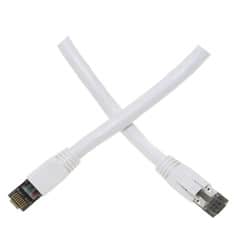 This 6-inch Category 8.1 cable, Class I channel, features a white PVC jacket, braided outer shield, with four individually mylar foil shielded 24 AWG pure copper pairs as defined in ISO/IEC 11801 and ratified in ANSI/TIA 568-C.2-1. Cat8 cabling was designed primarily for high-speed data centers where switches, servers, and other network hardware are located in close proximity. This newest copper communications cable offers greater flexibility both literally and in distances when compared to QSFP+ and Twinax DAC assemblies which typically cost significantly more and are often much more limited in scope. It has the reach to cover Top-of-Rack and End-of-Row or Middle-of-Row network topologies while delivering 10, 25, and 40 Gigabit data rates over BASE-T technology with RJ45 ends making it a drop-in replacement for Cat6a where rates beyond 10Gb will be needed today or in the future. Cat8 has stricter specifications for noise restriction and crosstalk than any of its predecessors. The individual conductors are 24 AWG (American wire gauge) stranded pure copper. Cat8 patch cables are stranded to improve flexibility. Pure copper conductors provide the best signal possible. Each pair of conductors is shielded with an aluminum mylar foil to reduce, if not eliminate, crosstalk. These cables also have a braided shield, which protects from outside electromagnetic interference.Part No. 13X8-59100.5
This 6-inch Category 8.1 cable, Class I channel, features a white PVC jacket, braided outer shield, with four individually mylar foil shielded 24 AWG pure copper pairs as defined in ISO/IEC 11801 and ratified in ANSI/TIA 568-C.2-1. Cat8 cabling was designed primarily for high-speed data centers where switches, servers, and other network hardware are located in close proximity. This newest copper communications cable offers greater flexibility both literally and in distances when compared to QSFP+ and Twinax DAC assemblies which typically cost significantly more and are often much more limited in scope. It has the reach to cover Top-of-Rack and End-of-Row or Middle-of-Row network topologies while delivering 10, 25, and 40 Gigabit data rates over BASE-T technology with RJ45 ends making it a drop-in replacement for Cat6a where rates beyond 10Gb will be needed today or in the future. Cat8 has stricter specifications for noise restriction and crosstalk than any of its predecessors. The individual conductors are 24 AWG (American wire gauge) stranded pure copper. Cat8 patch cables are stranded to improve flexibility. Pure copper conductors provide the best signal possible. Each pair of conductors is shielded with an aluminum mylar foil to reduce, if not eliminate, crosstalk. These cables also have a braided shield, which protects from outside electromagnetic interference.Part No. 13X8-59100.5 -
 This 1-foot Category 8.1 cable, Class I channel, features a white PVC jacket, braided outer shield, with four individually mylar foil shielded 24 AWG pure copper pairs as defined in ISO/IEC 11801 and ratified in ANSI/TIA 568-C.2-1. Cat8 cabling was designed primarily for high-speed data centers where switches, servers, and other network hardware are located in close proximity. This newest copper communications cable offers greater flexibility both literally and in distances when compared to QSFP+ and Twinax DAC assemblies which typically cost significantly more and are often much more limited in scope. It has the reach to cover Top-of-Rack and End-of-Row or Middle-of-Row network topologies while delivering 10, 25, and 40 Gigabit data rates over BASE-T technology with RJ45 ends making it a drop-in replacement for Cat6a where rates beyond 10Gb will be needed today or in the future. Cat8 has stricter specifications for noise restriction and crosstalk than any of its predecessors. The individual conductors are 24 AWG (American wire gauge) stranded pure copper. Cat8 patch cables are stranded to improve flexibility. Pure copper conductors provide the best signal possible. Each pair of conductors is shielded with an aluminum mylar foil to reduce, if not eliminate, crosstalk. These cables also have a braided shield, which protects from outside electromagnetic interference.Part No. 13X8-59101
This 1-foot Category 8.1 cable, Class I channel, features a white PVC jacket, braided outer shield, with four individually mylar foil shielded 24 AWG pure copper pairs as defined in ISO/IEC 11801 and ratified in ANSI/TIA 568-C.2-1. Cat8 cabling was designed primarily for high-speed data centers where switches, servers, and other network hardware are located in close proximity. This newest copper communications cable offers greater flexibility both literally and in distances when compared to QSFP+ and Twinax DAC assemblies which typically cost significantly more and are often much more limited in scope. It has the reach to cover Top-of-Rack and End-of-Row or Middle-of-Row network topologies while delivering 10, 25, and 40 Gigabit data rates over BASE-T technology with RJ45 ends making it a drop-in replacement for Cat6a where rates beyond 10Gb will be needed today or in the future. Cat8 has stricter specifications for noise restriction and crosstalk than any of its predecessors. The individual conductors are 24 AWG (American wire gauge) stranded pure copper. Cat8 patch cables are stranded to improve flexibility. Pure copper conductors provide the best signal possible. Each pair of conductors is shielded with an aluminum mylar foil to reduce, if not eliminate, crosstalk. These cables also have a braided shield, which protects from outside electromagnetic interference.Part No. 13X8-59101 -
 This 2-foot Category 8.1 cable, Class I channel, features a white PVC jacket, braided outer shield, with four individually mylar foil shielded 24 AWG pure copper pairs as defined in ISO/IEC 11801 and ratified in ANSI/TIA 568-C.2-1. Cat8 cabling was designed primarily for high-speed data centers where switches, servers, and other network hardware are located in close proximity. This newest copper communications cable offers greater flexibility both literally and in distances when compared to QSFP+ and Twinax DAC assemblies which typically cost significantly more and are often much more limited in scope. It has the reach to cover Top-of-Rack and End-of-Row or Middle-of-Row network topologies while delivering 10, 25, and 40 Gigabit data rates over BASE-T technology with RJ45 ends making it a drop-in replacement for Cat6a where rates beyond 10Gb will be needed today or in the future. Cat8 has stricter specifications for noise restriction and crosstalk than any of its predecessors. The individual conductors are 24 AWG (American wire gauge) stranded pure copper. Cat8 patch cables are stranded to improve flexibility. Pure copper conductors provide the best signal possible. Each pair of conductors is shielded with an aluminum mylar foil to reduce, if not eliminate, crosstalk. These cables also have a braided shield, which protects from outside electromagnetic interference.Part No. 13X8-59102
This 2-foot Category 8.1 cable, Class I channel, features a white PVC jacket, braided outer shield, with four individually mylar foil shielded 24 AWG pure copper pairs as defined in ISO/IEC 11801 and ratified in ANSI/TIA 568-C.2-1. Cat8 cabling was designed primarily for high-speed data centers where switches, servers, and other network hardware are located in close proximity. This newest copper communications cable offers greater flexibility both literally and in distances when compared to QSFP+ and Twinax DAC assemblies which typically cost significantly more and are often much more limited in scope. It has the reach to cover Top-of-Rack and End-of-Row or Middle-of-Row network topologies while delivering 10, 25, and 40 Gigabit data rates over BASE-T technology with RJ45 ends making it a drop-in replacement for Cat6a where rates beyond 10Gb will be needed today or in the future. Cat8 has stricter specifications for noise restriction and crosstalk than any of its predecessors. The individual conductors are 24 AWG (American wire gauge) stranded pure copper. Cat8 patch cables are stranded to improve flexibility. Pure copper conductors provide the best signal possible. Each pair of conductors is shielded with an aluminum mylar foil to reduce, if not eliminate, crosstalk. These cables also have a braided shield, which protects from outside electromagnetic interference.Part No. 13X8-59102 -
 This 3-foot Category 8.1 cable, Class I channel, features a white PVC jacket, braided outer shield, with four individually mylar foil shielded 24 AWG pure copper pairs as defined in ISO/IEC 11801 and ratified in ANSI/TIA 568-C.2-1. Cat8 cabling was designed primarily for high-speed data centers where switches, servers, and other network hardware are located in close proximity. This newest copper communications cable offers greater flexibility both literally and in distances when compared to QSFP+ and Twinax DAC assemblies which typically cost significantly more and are often much more limited in scope. It has the reach to cover Top-of-Rack and End-of-Row or Middle-of-Row network topologies while delivering 10, 25, and 40 Gigabit data rates over BASE-T technology with RJ45 ends making it a drop-in replacement for Cat6a where rates beyond 10Gb will be needed today or in the future. Cat8 has stricter specifications for noise restriction and crosstalk than any of its predecessors. The individual conductors are 24 AWG (American wire gauge) stranded pure copper. Cat8 patch cables are stranded to improve flexibility. Pure copper conductors provide the best signal possible. Each pair of conductors is shielded with an aluminum mylar foil to reduce, if not eliminate, crosstalk. These cables also have a braided shield, which protects from outside electromagnetic interference.Part No. 13X8-59103
This 3-foot Category 8.1 cable, Class I channel, features a white PVC jacket, braided outer shield, with four individually mylar foil shielded 24 AWG pure copper pairs as defined in ISO/IEC 11801 and ratified in ANSI/TIA 568-C.2-1. Cat8 cabling was designed primarily for high-speed data centers where switches, servers, and other network hardware are located in close proximity. This newest copper communications cable offers greater flexibility both literally and in distances when compared to QSFP+ and Twinax DAC assemblies which typically cost significantly more and are often much more limited in scope. It has the reach to cover Top-of-Rack and End-of-Row or Middle-of-Row network topologies while delivering 10, 25, and 40 Gigabit data rates over BASE-T technology with RJ45 ends making it a drop-in replacement for Cat6a where rates beyond 10Gb will be needed today or in the future. Cat8 has stricter specifications for noise restriction and crosstalk than any of its predecessors. The individual conductors are 24 AWG (American wire gauge) stranded pure copper. Cat8 patch cables are stranded to improve flexibility. Pure copper conductors provide the best signal possible. Each pair of conductors is shielded with an aluminum mylar foil to reduce, if not eliminate, crosstalk. These cables also have a braided shield, which protects from outside electromagnetic interference.Part No. 13X8-59103 -
 This 5-foot Category 8.1 cable, Class I channel, features a white PVC jacket, braided outer shield, with four individually mylar foil shielded 24 AWG pure copper pairs as defined in ISO/IEC 11801 and ratified in ANSI/TIA 568-C.2-1. Cat8 cabling was designed primarily for high-speed data centers where switches, servers, and other network hardware are located in close proximity. This newest copper communications cable offers greater flexibility both literally and in distances when compared to QSFP+ and Twinax DAC assemblies which typically cost significantly more and are often much more limited in scope. It has the reach to cover Top-of-Rack and End-of-Row or Middle-of-Row network topologies while delivering 10, 25, and 40 Gigabit data rates over BASE-T technology with RJ45 ends making it a drop-in replacement for Cat6a where rates beyond 10Gb will be needed today or in the future. Cat8 has stricter specifications for noise restriction and crosstalk than any of its predecessors. The individual conductors are 24 AWG (American wire gauge) stranded pure copper. Cat8 patch cables are stranded to improve flexibility. Pure copper conductors provide the best signal possible. Each pair of conductors is shielded with an aluminum mylar foil to reduce, if not eliminate, crosstalk. These cables also have a braided shield, which protects from outside electromagnetic interference.Part No. 13X8-59105
This 5-foot Category 8.1 cable, Class I channel, features a white PVC jacket, braided outer shield, with four individually mylar foil shielded 24 AWG pure copper pairs as defined in ISO/IEC 11801 and ratified in ANSI/TIA 568-C.2-1. Cat8 cabling was designed primarily for high-speed data centers where switches, servers, and other network hardware are located in close proximity. This newest copper communications cable offers greater flexibility both literally and in distances when compared to QSFP+ and Twinax DAC assemblies which typically cost significantly more and are often much more limited in scope. It has the reach to cover Top-of-Rack and End-of-Row or Middle-of-Row network topologies while delivering 10, 25, and 40 Gigabit data rates over BASE-T technology with RJ45 ends making it a drop-in replacement for Cat6a where rates beyond 10Gb will be needed today or in the future. Cat8 has stricter specifications for noise restriction and crosstalk than any of its predecessors. The individual conductors are 24 AWG (American wire gauge) stranded pure copper. Cat8 patch cables are stranded to improve flexibility. Pure copper conductors provide the best signal possible. Each pair of conductors is shielded with an aluminum mylar foil to reduce, if not eliminate, crosstalk. These cables also have a braided shield, which protects from outside electromagnetic interference.Part No. 13X8-59105 -
 This 7-foot Category 8.1 cable, Class I channel, features a white PVC jacket, braided outer shield, with four individually mylar foil shielded 24 AWG pure copper pairs as defined in ISO/IEC 11801 and ratified in ANSI/TIA 568-C.2-1. Cat8 cabling was designed primarily for high-speed data centers where switches, servers, and other network hardware are located in close proximity. This newest copper communications cable offers greater flexibility both literally and in distances when compared to QSFP+ and Twinax DAC assemblies which typically cost significantly more and are often much more limited in scope. It has the reach to cover Top-of-Rack and End-of-Row or Middle-of-Row network topologies while delivering 10, 25, and 40 Gigabit data rates over BASE-T technology with RJ45 ends making it a drop-in replacement for Cat6a where rates beyond 10Gb will be needed today or in the future. Cat8 has stricter specifications for noise restriction and crosstalk than any of its predecessors. The individual conductors are 24 AWG (American wire gauge) stranded pure copper. Cat8 patch cables are stranded to improve flexibility. Pure copper conductors provide the best signal possible. Each pair of conductors is shielded with an aluminum mylar foil to reduce, if not eliminate, crosstalk. These cables also have a braided shield, which protects from outside electromagnetic interference.Part No. 13X8-59107
This 7-foot Category 8.1 cable, Class I channel, features a white PVC jacket, braided outer shield, with four individually mylar foil shielded 24 AWG pure copper pairs as defined in ISO/IEC 11801 and ratified in ANSI/TIA 568-C.2-1. Cat8 cabling was designed primarily for high-speed data centers where switches, servers, and other network hardware are located in close proximity. This newest copper communications cable offers greater flexibility both literally and in distances when compared to QSFP+ and Twinax DAC assemblies which typically cost significantly more and are often much more limited in scope. It has the reach to cover Top-of-Rack and End-of-Row or Middle-of-Row network topologies while delivering 10, 25, and 40 Gigabit data rates over BASE-T technology with RJ45 ends making it a drop-in replacement for Cat6a where rates beyond 10Gb will be needed today or in the future. Cat8 has stricter specifications for noise restriction and crosstalk than any of its predecessors. The individual conductors are 24 AWG (American wire gauge) stranded pure copper. Cat8 patch cables are stranded to improve flexibility. Pure copper conductors provide the best signal possible. Each pair of conductors is shielded with an aluminum mylar foil to reduce, if not eliminate, crosstalk. These cables also have a braided shield, which protects from outside electromagnetic interference.Part No. 13X8-59107 -
 This 15-foot Category 8.1 cable, Class I channel, features a white PVC jacket, braided outer shield, with four individually mylar foil shielded 24 AWG pure copper pairs as defined in ISO/IEC 11801 and ratified in ANSI/TIA 568-C.2-1. Cat8 cabling was designed primarily for high-speed data centers where switches, servers, and other network hardware are located in close proximity. This newest copper communications cable offers greater flexibility both literally and in distances when compared to QSFP+ and Twinax DAC assemblies which typically cost significantly more and are often much more limited in scope. It has the reach to cover Top-of-Rack and End-of-Row or Middle-of-Row network topologies while delivering 10, 25, and 40 Gigabit data rates over BASE-T technology with RJ45 ends making it a drop-in replacement for Cat6a where rates beyond 10Gb will be needed today or in the future. Cat8 has stricter specifications for noise restriction and crosstalk than any of its predecessors. The individual conductors are 24 AWG (American wire gauge) stranded pure copper. Cat8 patch cables are stranded to improve flexibility. Pure copper conductors provide the best signal possible. Each pair of conductors is shielded with an aluminum mylar foil to reduce, if not eliminate, crosstalk. These cables also have a braided shield, which protects from outside electromagnetic interference.Part No. 13X8-59115
This 15-foot Category 8.1 cable, Class I channel, features a white PVC jacket, braided outer shield, with four individually mylar foil shielded 24 AWG pure copper pairs as defined in ISO/IEC 11801 and ratified in ANSI/TIA 568-C.2-1. Cat8 cabling was designed primarily for high-speed data centers where switches, servers, and other network hardware are located in close proximity. This newest copper communications cable offers greater flexibility both literally and in distances when compared to QSFP+ and Twinax DAC assemblies which typically cost significantly more and are often much more limited in scope. It has the reach to cover Top-of-Rack and End-of-Row or Middle-of-Row network topologies while delivering 10, 25, and 40 Gigabit data rates over BASE-T technology with RJ45 ends making it a drop-in replacement for Cat6a where rates beyond 10Gb will be needed today or in the future. Cat8 has stricter specifications for noise restriction and crosstalk than any of its predecessors. The individual conductors are 24 AWG (American wire gauge) stranded pure copper. Cat8 patch cables are stranded to improve flexibility. Pure copper conductors provide the best signal possible. Each pair of conductors is shielded with an aluminum mylar foil to reduce, if not eliminate, crosstalk. These cables also have a braided shield, which protects from outside electromagnetic interference.Part No. 13X8-59115 -
 This cable is constructed of two Cat6 cables (Blue and Grey) and two RG6 cables (Black and White) bundled inside of an outer jacket (CM Rated) and a maximum operating temperature of 75C. Each Cat6 cable is constructed with 4 solid copper 23AWG twisted pairs and a center spline. Jacket is CM Rated. Each RG6 coaxial cable is quad shielded 3.0 GHz: outer aluminum braid (40% coverage), outer double foil of aluminum, inner aluminum braid (60% coverage) and one more aluminum foil layer. The center conductor is CCS (copper clad steel)Part No. 14X4-161NF
This cable is constructed of two Cat6 cables (Blue and Grey) and two RG6 cables (Black and White) bundled inside of an outer jacket (CM Rated) and a maximum operating temperature of 75C. Each Cat6 cable is constructed with 4 solid copper 23AWG twisted pairs and a center spline. Jacket is CM Rated. Each RG6 coaxial cable is quad shielded 3.0 GHz: outer aluminum braid (40% coverage), outer double foil of aluminum, inner aluminum braid (60% coverage) and one more aluminum foil layer. The center conductor is CCS (copper clad steel)Part No. 14X4-161NF -
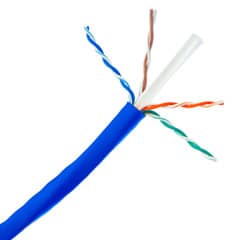 Our blue plenum solid Cat6a Ethernet cable is used for networking and phone infrastructure and comes in a convenient spool. Cat6a Cable is used in network applications and has been designed specifically for 10 Gigabit Ethernet applications. This particular cable is a plenum rated blue UTP (Unshielded Twisted Pair) bulk cable. The individual conductors are 23 AWG (American wire gauge) solid pure copper. Our Cat6a Ethernet cable exceeds the EIA/TIA-568-C standard. In a typical residential environment, an in-wall rated cable will suffice. However, commercial installations of cabling will have more requirements. In commercial buildings, there will be an area between floors or above office areas for heating/cooling airflow called the Plenum. If an office were to catch fire, this plenum area could easily allow the spread of the fire to more floors or across the entire building. Cables that do not have a jacket rated for in wall or plenum use could actually cause the fire to become more intense. Plenum rated cables are jacketed with a fire-retardant plastic jacket of either a low-smoke polyvinyl chloride (PVC) or a fluorinated ethylene polymer (FEP) for less toxicity during a fire. If a fire gets into a plenum rated area that contains plenum rated cables and the fire spreads, the cables will not be to blame.Part No. 14X6-061NH
Our blue plenum solid Cat6a Ethernet cable is used for networking and phone infrastructure and comes in a convenient spool. Cat6a Cable is used in network applications and has been designed specifically for 10 Gigabit Ethernet applications. This particular cable is a plenum rated blue UTP (Unshielded Twisted Pair) bulk cable. The individual conductors are 23 AWG (American wire gauge) solid pure copper. Our Cat6a Ethernet cable exceeds the EIA/TIA-568-C standard. In a typical residential environment, an in-wall rated cable will suffice. However, commercial installations of cabling will have more requirements. In commercial buildings, there will be an area between floors or above office areas for heating/cooling airflow called the Plenum. If an office were to catch fire, this plenum area could easily allow the spread of the fire to more floors or across the entire building. Cables that do not have a jacket rated for in wall or plenum use could actually cause the fire to become more intense. Plenum rated cables are jacketed with a fire-retardant plastic jacket of either a low-smoke polyvinyl chloride (PVC) or a fluorinated ethylene polymer (FEP) for less toxicity during a fire. If a fire gets into a plenum rated area that contains plenum rated cables and the fire spreads, the cables will not be to blame.Part No. 14X6-061NH -
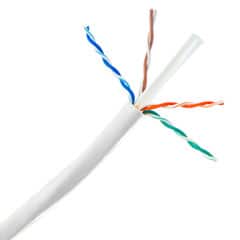 Our white plenum solid Cat6a Ethernet cable is used for networking and phone infrastructure and comes in a convenient spool. Cat6a Cable is used in network applications and has been designed specifically for 10 Gigabit Ethernet applications. This particular cable is a plenum rated white UTP (Unshielded Twisted Pair) bulk cable. The individual conductors are 23 AWG (American wire gauge) solid pure copper. Our Cat6a Ethernet cable exceeds the EIA/TIA-568-C standard. In a typical residential environment, an in-wall rated cable will suffice. However, commercial installations of cabling will have more requirements. In commercial buildings, there will be an area between floors or above office areas for heating/cooling airflow called the Plenum. If an office were to catch fire, this plenum area could easily allow the spread of the fire to more floors or across the entire building. Cables that do not have a jacket rated for in wall or plenum use could actually cause the fire to become more intense. Plenum rated cables are jacketed with a fire-retardant plastic jacket of either a low-smoke polyvinyl chloride (PVC) or a fluorinated ethylene polymer (FEP) for less toxicity during a fire. If a fire gets into a plenum rated area that contains plenum rated cables and the fire spreads, the cables will not be to blame.Part No. 14X6-091NH
Our white plenum solid Cat6a Ethernet cable is used for networking and phone infrastructure and comes in a convenient spool. Cat6a Cable is used in network applications and has been designed specifically for 10 Gigabit Ethernet applications. This particular cable is a plenum rated white UTP (Unshielded Twisted Pair) bulk cable. The individual conductors are 23 AWG (American wire gauge) solid pure copper. Our Cat6a Ethernet cable exceeds the EIA/TIA-568-C standard. In a typical residential environment, an in-wall rated cable will suffice. However, commercial installations of cabling will have more requirements. In commercial buildings, there will be an area between floors or above office areas for heating/cooling airflow called the Plenum. If an office were to catch fire, this plenum area could easily allow the spread of the fire to more floors or across the entire building. Cables that do not have a jacket rated for in wall or plenum use could actually cause the fire to become more intense. Plenum rated cables are jacketed with a fire-retardant plastic jacket of either a low-smoke polyvinyl chloride (PVC) or a fluorinated ethylene polymer (FEP) for less toxicity during a fire. If a fire gets into a plenum rated area that contains plenum rated cables and the fire spreads, the cables will not be to blame.Part No. 14X6-091NH



